- Privacy Policy
Buy Me a Coffee

Home » How To Write A Research Proposal – Step-by-Step [Template]

How To Write A Research Proposal – Step-by-Step [Template]
Table of Contents

How To Write a Research Proposal
Writing a Research proposal involves several steps to ensure a well-structured and comprehensive document. Here is an explanation of each step:
1. Title and Abstract
- Choose a concise and descriptive title that reflects the essence of your research.
- Write an abstract summarizing your research question, objectives, methodology, and expected outcomes. It should provide a brief overview of your proposal.
2. Introduction:
- Provide an introduction to your research topic, highlighting its significance and relevance.
- Clearly state the research problem or question you aim to address.
- Discuss the background and context of the study, including previous research in the field.
3. Research Objectives
- Outline the specific objectives or aims of your research. These objectives should be clear, achievable, and aligned with the research problem.
4. Literature Review:
- Conduct a comprehensive review of relevant literature and studies related to your research topic.
- Summarize key findings, identify gaps, and highlight how your research will contribute to the existing knowledge.
5. Methodology:
- Describe the research design and methodology you plan to employ to address your research objectives.
- Explain the data collection methods, instruments, and analysis techniques you will use.
- Justify why the chosen methods are appropriate and suitable for your research.
6. Timeline:
- Create a timeline or schedule that outlines the major milestones and activities of your research project.
- Break down the research process into smaller tasks and estimate the time required for each task.
7. Resources:
- Identify the resources needed for your research, such as access to specific databases, equipment, or funding.
- Explain how you will acquire or utilize these resources to carry out your research effectively.
8. Ethical Considerations:
- Discuss any ethical issues that may arise during your research and explain how you plan to address them.
- If your research involves human subjects, explain how you will ensure their informed consent and privacy.
9. Expected Outcomes and Significance:
- Clearly state the expected outcomes or results of your research.
- Highlight the potential impact and significance of your research in advancing knowledge or addressing practical issues.
10. References:
- Provide a list of all the references cited in your proposal, following a consistent citation style (e.g., APA, MLA).
11. Appendices:
- Include any additional supporting materials, such as survey questionnaires, interview guides, or data analysis plans.
Research Proposal Format
The format of a research proposal may vary depending on the specific requirements of the institution or funding agency. However, the following is a commonly used format for a research proposal:
1. Title Page:
- Include the title of your research proposal, your name, your affiliation or institution, and the date.
2. Abstract:
- Provide a brief summary of your research proposal, highlighting the research problem, objectives, methodology, and expected outcomes.
3. Introduction:
- Introduce the research topic and provide background information.
- State the research problem or question you aim to address.
- Explain the significance and relevance of the research.
- Review relevant literature and studies related to your research topic.
- Summarize key findings and identify gaps in the existing knowledge.
- Explain how your research will contribute to filling those gaps.
5. Research Objectives:
- Clearly state the specific objectives or aims of your research.
- Ensure that the objectives are clear, focused, and aligned with the research problem.
6. Methodology:
- Describe the research design and methodology you plan to use.
- Explain the data collection methods, instruments, and analysis techniques.
- Justify why the chosen methods are appropriate for your research.
7. Timeline:
8. Resources:
- Explain how you will acquire or utilize these resources effectively.
9. Ethical Considerations:
- If applicable, explain how you will ensure informed consent and protect the privacy of research participants.
10. Expected Outcomes and Significance:
11. References:
12. Appendices:
Research Proposal Template
Here’s a template for a research proposal:
1. Introduction:
2. Literature Review:
3. Research Objectives:
4. Methodology:
5. Timeline:
6. Resources:
7. Ethical Considerations:
8. Expected Outcomes and Significance:
9. References:
10. Appendices:
Research Proposal Sample
Title: The Impact of Online Education on Student Learning Outcomes: A Comparative Study
1. Introduction
Online education has gained significant prominence in recent years, especially due to the COVID-19 pandemic. This research proposal aims to investigate the impact of online education on student learning outcomes by comparing them with traditional face-to-face instruction. The study will explore various aspects of online education, such as instructional methods, student engagement, and academic performance, to provide insights into the effectiveness of online learning.
2. Objectives
The main objectives of this research are as follows:
- To compare student learning outcomes between online and traditional face-to-face education.
- To examine the factors influencing student engagement in online learning environments.
- To assess the effectiveness of different instructional methods employed in online education.
- To identify challenges and opportunities associated with online education and suggest recommendations for improvement.
3. Methodology
3.1 Study Design
This research will utilize a mixed-methods approach to gather both quantitative and qualitative data. The study will include the following components:
3.2 Participants
The research will involve undergraduate students from two universities, one offering online education and the other providing face-to-face instruction. A total of 500 students (250 from each university) will be selected randomly to participate in the study.
3.3 Data Collection
The research will employ the following data collection methods:
- Quantitative: Pre- and post-assessments will be conducted to measure students’ learning outcomes. Data on student demographics and academic performance will also be collected from university records.
- Qualitative: Focus group discussions and individual interviews will be conducted with students to gather their perceptions and experiences regarding online education.
3.4 Data Analysis
Quantitative data will be analyzed using statistical software, employing descriptive statistics, t-tests, and regression analysis. Qualitative data will be transcribed, coded, and analyzed thematically to identify recurring patterns and themes.
4. Ethical Considerations
The study will adhere to ethical guidelines, ensuring the privacy and confidentiality of participants. Informed consent will be obtained, and participants will have the right to withdraw from the study at any time.
5. Significance and Expected Outcomes
This research will contribute to the existing literature by providing empirical evidence on the impact of online education on student learning outcomes. The findings will help educational institutions and policymakers make informed decisions about incorporating online learning methods and improving the quality of online education. Moreover, the study will identify potential challenges and opportunities related to online education and offer recommendations for enhancing student engagement and overall learning outcomes.
6. Timeline
The proposed research will be conducted over a period of 12 months, including data collection, analysis, and report writing.
The estimated budget for this research includes expenses related to data collection, software licenses, participant compensation, and research assistance. A detailed budget breakdown will be provided in the final research plan.
8. Conclusion
This research proposal aims to investigate the impact of online education on student learning outcomes through a comparative study with traditional face-to-face instruction. By exploring various dimensions of online education, this research will provide valuable insights into the effectiveness and challenges associated with online learning. The findings will contribute to the ongoing discourse on educational practices and help shape future strategies for maximizing student learning outcomes in online education settings.
About the author
Muhammad Hassan
Researcher, Academic Writer, Web developer
You may also like

How To Write A Proposal – Step By Step Guide...

Grant Proposal – Example, Template and Guide

How To Write A Business Proposal – Step-by-Step...

Business Proposal – Templates, Examples and Guide

Proposal – Types, Examples, and Writing Guide

How to choose an Appropriate Method for Research?
How to write a research plan: Step-by-step guide
Last updated
30 January 2024
Reviewed by
Today’s businesses and institutions rely on data and analytics to inform their product and service decisions. These metrics influence how organizations stay competitive and inspire innovation. However, gathering data and insights requires carefully constructed research, and every research project needs a roadmap. This is where a research plan comes into play.
There’s general research planning; then there’s an official, well-executed research plan. Whatever data-driven research project you’re gearing up for, the research plan will be your framework for execution. The plan should also be detailed and thorough, with a diligent set of criteria to formulate your research efforts. Not including these key elements in your plan can be just as harmful as having no plan at all.
Read this step-by-step guide for writing a detailed research plan that can apply to any project, whether it’s scientific, educational, or business-related.
- What is a research plan?
A research plan is a documented overview of a project in its entirety, from end to end. It details the research efforts, participants, and methods needed, along with any anticipated results. It also outlines the project’s goals and mission, creating layers of steps to achieve those goals within a specified timeline.
Without a research plan, you and your team are flying blind, potentially wasting time and resources to pursue research without structured guidance.
The principal investigator, or PI, is responsible for facilitating the research oversight. They will create the research plan and inform team members and stakeholders of every detail relating to the project. The PI will also use the research plan to inform decision-making throughout the project.
- Why do you need a research plan?
Create a research plan before starting any official research to maximize every effort in pursuing and collecting the research data. Crucially, the plan will model the activities needed at each phase of the research project.
Like any roadmap, a research plan serves as a valuable tool providing direction for those involved in the project—both internally and externally. It will keep you and your immediate team organized and task-focused while also providing necessary definitions and timelines so you can execute your project initiatives with full understanding and transparency.
External stakeholders appreciate a working research plan because it’s a great communication tool, documenting progress and changing dynamics as they arise. Any participants of your planned research sessions will be informed about the purpose of your study, while the exercises will be based on the key messaging outlined in the official plan.
Here are some of the benefits of creating a research plan document for every project:
Project organization and structure
Well-informed participants
All stakeholders and teams align in support of the project
Clearly defined project definitions and purposes
Distractions are eliminated, prioritizing task focus
Timely management of individual task schedules and roles
Costly reworks are avoided
- What should a research plan include?
The different aspects of your research plan will depend on the nature of the project. However, most official research plan documents will include the core elements below. Each aims to define the problem statement, devising an official plan for seeking a solution.
Specific project goals and individual objectives
Ideal strategies or methods for reaching those goals
Required resources
Descriptions of the target audience, sample sizes, demographics, and scopes
Key performance indicators (KPIs)
Project background
Research and testing support
Preliminary studies and progress reporting mechanisms
Cost estimates and change order processes
Depending on the research project’s size and scope, your research plan could be brief—perhaps only a few pages of documented plans. Alternatively, it could be a fully comprehensive report. Either way, it’s an essential first step in dictating your project’s facilitation in the most efficient and effective way.
- How to write a research plan for your project
When you start writing your research plan, aim to be detailed about each step, requirement, and idea. The more time you spend curating your research plan, the more precise your research execution efforts will be.
Account for every potential scenario, and be sure to address each and every aspect of the research.
Consider following this flow to develop a great research plan for your project:
Define your project’s purpose
Start by defining your project’s purpose. Identify what your project aims to accomplish and what you are researching. Remember to use clear language.
Thinking about the project’s purpose will help you set realistic goals and inform how you divide tasks and assign responsibilities. These individual tasks will be your stepping stones to reach your overarching goal.
Additionally, you’ll want to identify the specific problem, the usability metrics needed, and the intended solutions.
Know the following three things about your project’s purpose before you outline anything else:
What you’re doing
Why you’re doing it
What you expect from it
Identify individual objectives
With your overarching project objectives in place, you can identify any individual goals or steps needed to reach those objectives. Break them down into phases or steps. You can work backward from the project goal and identify every process required to facilitate it.
Be mindful to identify each unique task so that you can assign responsibilities to various team members. At this point in your research plan development, you’ll also want to assign priority to those smaller, more manageable steps and phases that require more immediate or dedicated attention.
Select research methods
Research methods might include any of the following:
User interviews: this is a qualitative research method where researchers engage with participants in one-on-one or group conversations. The aim is to gather insights into their experiences, preferences, and opinions to uncover patterns, trends, and data.
Field studies: this approach allows for a contextual understanding of behaviors, interactions, and processes in real-world settings. It involves the researcher immersing themselves in the field, conducting observations, interviews, or experiments to gather in-depth insights.
Card sorting: participants categorize information by sorting content cards into groups based on their perceived similarities. You might use this process to gain insights into participants’ mental models and preferences when navigating or organizing information on websites, apps, or other systems.
Focus groups: use organized discussions among select groups of participants to provide relevant views and experiences about a particular topic.
Diary studies: ask participants to record their experiences, thoughts, and activities in a diary over a specified period. This method provides a deeper understanding of user experiences, uncovers patterns, and identifies areas for improvement.
Five-second testing: participants are shown a design, such as a web page or interface, for just five seconds. They then answer questions about their initial impressions and recall, allowing you to evaluate the design’s effectiveness.
Surveys: get feedback from participant groups with structured surveys. You can use online forms, telephone interviews, or paper questionnaires to reveal trends, patterns, and correlations.
Tree testing: tree testing involves researching web assets through the lens of findability and navigability. Participants are given a textual representation of the site’s hierarchy (the “tree”) and asked to locate specific information or complete tasks by selecting paths.
Usability testing: ask participants to interact with a product, website, or application to evaluate its ease of use. This method enables you to uncover areas for improvement in digital key feature functionality by observing participants using the product.
Live website testing: research and collect analytics that outlines the design, usability, and performance efficiencies of a website in real time.
There are no limits to the number of research methods you could use within your project. Just make sure your research methods help you determine the following:
What do you plan to do with the research findings?
What decisions will this research inform? How can your stakeholders leverage the research data and results?
Recruit participants and allocate tasks
Next, identify the participants needed to complete the research and the resources required to complete the tasks. Different people will be proficient at different tasks, and having a task allocation plan will allow everything to run smoothly.
Prepare a thorough project summary
Every well-designed research plan will feature a project summary. This official summary will guide your research alongside its communications or messaging. You’ll use the summary while recruiting participants and during stakeholder meetings. It can also be useful when conducting field studies.
Ensure this summary includes all the elements of your research project. Separate the steps into an easily explainable piece of text that includes the following:
An introduction: the message you’ll deliver to participants about the interview, pre-planned questioning, and testing tasks.
Interview questions: prepare questions you intend to ask participants as part of your research study, guiding the sessions from start to finish.
An exit message: draft messaging your teams will use to conclude testing or survey sessions. These should include the next steps and express gratitude for the participant’s time.
Create a realistic timeline
While your project might already have a deadline or a results timeline in place, you’ll need to consider the time needed to execute it effectively.
Realistically outline the time needed to properly execute each supporting phase of research and implementation. And, as you evaluate the necessary schedules, be sure to include additional time for achieving each milestone in case any changes or unexpected delays arise.
For this part of your research plan, you might find it helpful to create visuals to ensure your research team and stakeholders fully understand the information.
Determine how to present your results
A research plan must also describe how you intend to present your results. Depending on the nature of your project and its goals, you might dedicate one team member (the PI) or assume responsibility for communicating the findings yourself.
In this part of the research plan, you’ll articulate how you’ll share the results. Detail any materials you’ll use, such as:
Presentations and slides
A project report booklet
A project findings pamphlet
Documents with key takeaways and statistics
Graphic visuals to support your findings
- Format your research plan
As you create your research plan, you can enjoy a little creative freedom. A plan can assume many forms, so format it how you see fit. Determine the best layout based on your specific project, intended communications, and the preferences of your teams and stakeholders.
Find format inspiration among the following layouts:
Written outlines
Narrative storytelling
Visual mapping
Graphic timelines
Remember, the research plan format you choose will be subject to change and adaptation as your research and findings unfold. However, your final format should ideally outline questions, problems, opportunities, and expectations.
- Research plan example
Imagine you’ve been tasked with finding out how to get more customers to order takeout from an online food delivery platform. The goal is to improve satisfaction and retain existing customers. You set out to discover why more people aren’t ordering and what it is they do want to order or experience.
You identify the need for a research project that helps you understand what drives customer loyalty. But before you jump in and start calling past customers, you need to develop a research plan—the roadmap that provides focus, clarity, and realistic details to the project.
Here’s an example outline of a research plan you might put together:
Project title
Project members involved in the research plan
Purpose of the project (provide a summary of the research plan’s intent)
Objective 1 (provide a short description for each objective)
Objective 2
Objective 3
Proposed timeline
Audience (detail the group you want to research, such as customers or non-customers)
Budget (how much you think it might cost to do the research)
Risk factors/contingencies (any potential risk factors that may impact the project’s success)
Remember, your research plan doesn’t have to reinvent the wheel—it just needs to fit your project’s unique needs and aims.
Customizing a research plan template
Some companies offer research plan templates to help get you started. However, it may make more sense to develop your own customized plan template. Be sure to include the core elements of a great research plan with your template layout, including the following:
Introductions to participants and stakeholders
Background problems and needs statement
Significance, ethics, and purpose
Research methods, questions, and designs
Preliminary beliefs and expectations
Implications and intended outcomes
Realistic timelines for each phase
Conclusion and presentations
How many pages should a research plan be?
Generally, a research plan can vary in length between 500 to 1,500 words. This is roughly three pages of content. More substantial projects will be 2,000 to 3,500 words, taking up four to seven pages of planning documents.
What is the difference between a research plan and a research proposal?
A research plan is a roadmap to success for research teams. A research proposal, on the other hand, is a dissertation aimed at convincing or earning the support of others. Both are relevant in creating a guide to follow to complete a project goal.
What are the seven steps to developing a research plan?
While each research project is different, it’s best to follow these seven general steps to create your research plan:
Defining the problem
Identifying goals
Choosing research methods
Recruiting participants
Preparing the brief or summary
Establishing task timelines
Defining how you will present the findings
Get started today
Go from raw data to valuable insights with a flexible research platform
Editor’s picks
Last updated: 21 December 2023
Last updated: 16 December 2023
Last updated: 6 October 2023
Last updated: 5 March 2024
Last updated: 25 November 2023
Last updated: 15 February 2024
Last updated: 11 March 2024
Last updated: 12 December 2023
Last updated: 6 March 2024
Last updated: 10 April 2023
Last updated: 20 December 2023
Latest articles
Related topics, log in or sign up.
Get started for free

Thesis, major paper, and major project proposals
- Definitions
- Introductory section
- Literature review
- Methodology
Schedule/work plan
- Other potential elements
- Proposal references
- Ask for help

If you're unsure if your research proposal requires a schedule or work plan, please consult your project handbook and/or speak with your instructor, advisor, or supervisor.
The information about schedules or work plans in proposals was gathered from RRU thesis and major project handbooks, current in 2020, from programs in the Faculty of Social and Applied Sciences, the Faculty of Management, and the College of Interdisciplinary Studies. If the details here differ from the information provided in the handbook for your project, please follow the handbook's directions.
Image credit: Image by Gerd Altmann from Pixabay

- In RRU's Anxiety About Academic Writing guide, this resource is open to everyone.
How Do I Plan the Various Stages of My Research Project?
- In SAGE Research Methods: Planning and Practicalities, look for How Do I Plan the Various Stages of My Research Project? drop down option. Access via this link requires a RRU username and password.
Learning Skills: Time Management
- In RRU's Learning Skills guide, this resource is open to everyone.
What Do I Need to Know About Time and Timetabling?
- In SAGE Research Methods: Planning and Practicalities, look for the What Do I Need to Know About Time and Timetabling? drop down option. Access via this link requires a RRU username and password.
Image credit: Image by Mohamed Assan from Pixabay
- << Previous: Methodology
- Next: Other potential elements >>
- Last Updated: Jan 8, 2024 12:29 PM
- URL: https://libguides.royalroads.ca/proposals

How to write a Research Proposal: Explained with Examples
At some time in your student phase, you will have to do a Thesis or Dissertation, and for that, you will have to submit a research proposal. A Research Proposal in its most basic definition is a formally structured document that explains what, why, and how of your research. This document explains What you plan to research (your topic or theme of research), Why you are doing this research (justifying your research topic), and How you will do (your approach to complete the research). The purpose of a proposal is to convince other people apart from yourself that the work you’re doing is suitable and feasible for your academic position.

The process of writing a research proposal is lengthy and time-consuming. Your proposal will need constant edits as you keep taking your work forward and continue receiving feedback. Although, there is a structure or a template that needs to be followed. This article will guide you through this strenuous task. So, let’s get to work!
Research Proposal: Example
[ Let us take a running example throughout the article so that we cover all the points. Let us assume that we are working on a dissertation that needs to study the relationship between Gender and Money. ]
The Title is one of the first things the reader comes across. Your title should be crisp yet communicate all that you are trying to convey to the reader. In academia, a title gets even more weightage because in a sea of resources, sometimes your research project can get ignored because the title didn’t speak for itself. Therefore, make sure that you brainstorm multiple title options and see which fits the best. Many times in academic writing we use two forms of titles: the Main Title and the Subtitle. If you think that you cannot justify your research using just a Title, you can add a subtitle which will then convey the rest of your explanation.
[ Explanation through an example: Our theme is “Gender and Money”.
We can thus keep our title as: A study of “Gendered Money” in the Rural households of Delhi. ]
Insider’s Info: If you are not confident about your title in your research proposal, then write “Tentative Title” in brackets and italic below your Title. In this way, your superiors (professor or supervisor) will know that you are still working on fixing the title.
Overview / Abstract
The overview, also known as abstract and/or introduction, is the first section that you write for your proposal. Your overview should be a single paragraph that explains to the reader what your whole research will be about. In a nutshell, you will use your abstract to present all the arguments that you will be taking in detail in your thesis or research. What you can do is introduce your theme a little along with your topic and the aim of your research. But beware and do not reveal all that you have in your pocket. Make sure to spend plenty of time writing your overview because it will be used to determine if your research is worth taking forward or reading.
Existing Literature
This is one of the most important parts of your research and proposal. It should be obvious that in such a huge universe of research, the topic chosen by you cannot be the first of its kind. Therefore, you have to locate your research in the arguments or themes which are already out there. To do so, what you have to do is read the existing literature on the same topic or theme as yours. Without reading the existing literature you cannot possibly form your arguments or start your research. But to write the portion of existing literature you have to be cautious. In the course of your dissertation, at some point either before or after you submit your proposal, you will be asked to submit a “Literature Review”. Though it is very similar to existing literature, it is NOT the same.
Difference between “Literature Review” and “Existing Literature”
A literature review is a detailed essay that discusses all the material which is already out there regarding your topic. For a literature review, you will have to mention all the literature you have read and then explain how they benefit you in your field of research.
Whereas, an existing literature segment in your research proposal is the compact version of a literature review. It is a two to three-paragraph portion that locates your research topic in the larger argument. Here you need not reveal all your literature resources, but only mention the major ones which will be recurring literature throughout your research.
[ Explanation through an example: Now we know that our topic is: Our theme is “A study of “Gendered Money” in the Rural households of Delhi.”
To find the existing literature on this topic you should find academic articles relating to the themes of money, gender, economy, income, etc. ]
Insider’s Info : There is no limit when it comes to how much you read. You can read 2 articles or 20 articles for your research. The number doesn’t matter, what matters is how you use those concepts and arguments in your own thesis.
Research Gap
As you read and gather knowledge on your topic, you will start forming your own views. This might lead you to two conclusions. First, there exists a lot of literature regarding the relationship between gender and money, but they are all lacking something. Second, in the bundle of existing literature, you can bring a fresh perspective. Both of these thoughts help you in formulating your research gap. A research gap is nothing but you justifying why you should continue with your research even when it has been discussed many times already. Quoting your research gap helps you make a place for yourself in the academic world.
Based on 1st Conclusion, you can say that the research gap you found was that most of the studies done on the theme of gendered money looked at the urban situation, and with your analysis of ‘rural’ households, you will fill the gap.
Based on 2nd Conclusion, you can say that all the existing literature is mostly written from the economic point of view, but through your research, you will try to bring a feminist viewpoint to the theme of gendered money. ]
Insider’s Info : If you are unable to find a research gap for your dissertation, the best hack to fall back on is to say that all the research done up to this point have been based on western notions and social facts, but you will conduct research which holds in your localized reality.
Research Question / Hypothesis
Once you are sorted with your existing literature and have located your research gap, this section will be the easiest to tackle. A research question or hypothesis is nothing but a set of questions that you will try and answer throughout the course of your research. It is very crucial to include research questions in your proposal because this tells your superiors exactly what you plan to do. The number of questions you set for yourself can vary according to the time, resources, and finances you have. But we still recommend that you have at least three research questions stated in your proposal.
[ Explanation through an example: Now that we know what our topic is: our theme is “A study of “gendered money” in the rural households of Delhi.”
Some of the research questions you can state can be,
- Study the division for uses of wages, based on who earned it and where it is getting utilized.
- How gender relations also play a role within the household not only in the form of kinship but in the indirect form of economics as well.
- How, even when we have the same currency signifying the meaning of money, it changes according to the source of who earned it.
- How moral values and judgments are added to the money comes from different sources. ]
Insider’s Info: If you are confused about your research question, you can look at the questions taken up by the other authors you studied and modify them according to your point of view. But we seriously recommend that the best way to do your research is by coming up with your research question on your own. Believe in yourself!
Research Methodology / Research Design
This part of the research proposal is about how you will conduct and complete your research. To understand better what research methodology is, we should first clarify the difference between methodology and method. Research Method is the technique used by you to conduct your research. A method includes the sources of collecting your data such as case studies, interviews, surveys, etc. On the other hand, Methodology is how you plan to apply your method . Your methodology determines how you execute various methods during the course of your dissertation.
Therefore, a research methodology, which is also known as research design, is where you tell your reader how you plan to do your research. You tell the step-by-step plan and then justify it. Your research methodology will inform your supervisor how you plan to use your research tools and methods.
Your methodology should explain where you are conducting the research and how. So for this research, your field will be rural Delhi. Explain why you chose to study rural households and not urban ones. Then comes the how, some of the methods you might want to opt for can be Interviews, Questionnaires, and/or Focused Group Discussions. Do not forget to mention your sample size, i.e., the number of people you plan to talk to. ]
Insider’s Info: Make sure that you justify all the methods you plan to use. The more you provide your supervisor with a justification; the more serious and formal you come out to be in front of them. Also, when you write your why down, it is hard to forget the track and get derailed from the goal.
This will not even be a section, but just 2 lines in your proposal where you will state the amount of time you plan to complete your dissertation and how you will utilize that time. This portion can also be included in your “Research Methodology” section. We have stated this as a separate subheading so that you do not miss out on this small but mighty aspect.
For this project, you can mention that you will be allocated 4 months, out of which 1 month will be utilized for fieldwork and the rest would be used for secondary research, compilation, and completion of the thesis. ]
Aim of the Research
The aim of the research is where you try to predict the result of your research. Your aim is what you wish to achieve at the end of this long process. This section also informs your supervisor how your research will be located in the ongoing larger argument corresponding to your selected topic/theme. Remember the research questions you set up for yourself earlier? This is the time when you envision answers to those questions.
You can present that through your research you will aim to find if the money which enters the household belongs equally to everyone, or does it get stratified and gendered in this realm. Through this research, you aim to present a fresh new perspective in the field of studies of gendered money. ]
Insider’s Info: The aim you write right now is just a prediction or the expected outcome. Therefore, even if the result of your research is different in the end it doesn’t matter.
Bibliography
The bibliography is the easiest and most sorted part of your proposal. It is nothing but a list of all the resources that you will study or already have studied for the completion of your research. This list will contain all the articles or essays mentioned by you in the existing literature section, and all the other things such as books, journal articles, reviews, news, etc.
The most basic format to write a bibliography is:
- Author’s Name with Surname mentioned first, then initials (Tiwari, E.)
- Article’s Title in single or double quotes ( ‘ ’ or “ ” )
- Journal Title in Italics ( Like this )
- Volume, issue number
- Year of Publication in brackets
Example: Tichenor, Veronica Jaris (1999). “Status and income as gendered resources: The case of marital power”. Journal of Marriage and Family . Pg 938-65 ]
Insider’s Info: You do not number or bullet your bibliography. They should be arranged alphabetically based on the surname of the author.
Learn: Citation with Examples
Also Check: How to Write Dissertation
https://www.uh.edu/~lsong5/documents/
https://www.yorksj.ac.uk/study/postgraduate/research/
Hello! Eiti is a budding sociologist whose passion lies in reading, researching, and writing. She thrives on coffee, to-do lists, deadlines, and organization. Eiti's primary interest areas encompass food, gender, and academia.
Have a language expert improve your writing
Run a free plagiarism check in 10 minutes, automatically generate references for free.
- Knowledge Base
- Research process
- How to Write a Research Proposal | Examples & Templates
How to Write a Research Proposal | Examples & Templates
Published on 30 October 2022 by Shona McCombes and Tegan George. Revised on 13 June 2023.

A research proposal describes what you will investigate, why it’s important, and how you will conduct your research.
The format of a research proposal varies between fields, but most proposals will contain at least these elements:
Introduction
Literature review.
- Research design
Reference list
While the sections may vary, the overall objective is always the same. A research proposal serves as a blueprint and guide for your research plan, helping you get organised and feel confident in the path forward you choose to take.
Table of contents
Research proposal purpose, research proposal examples, research design and methods, contribution to knowledge, research schedule, frequently asked questions.
Academics often have to write research proposals to get funding for their projects. As a student, you might have to write a research proposal as part of a grad school application , or prior to starting your thesis or dissertation .
In addition to helping you figure out what your research can look like, a proposal can also serve to demonstrate why your project is worth pursuing to a funder, educational institution, or supervisor.
Research proposal length
The length of a research proposal can vary quite a bit. A bachelor’s or master’s thesis proposal can be just a few pages, while proposals for PhD dissertations or research funding are usually much longer and more detailed. Your supervisor can help you determine the best length for your work.
One trick to get started is to think of your proposal’s structure as a shorter version of your thesis or dissertation , only without the results , conclusion and discussion sections.
Download our research proposal template
Prevent plagiarism, run a free check.
Writing a research proposal can be quite challenging, but a good starting point could be to look at some examples. We’ve included a few for you below.
- Example research proposal #1: ‘A Conceptual Framework for Scheduling Constraint Management’
- Example research proposal #2: ‘ Medical Students as Mediators of Change in Tobacco Use’
Like your dissertation or thesis, the proposal will usually have a title page that includes:
- The proposed title of your project
- Your supervisor’s name
- Your institution and department
The first part of your proposal is the initial pitch for your project. Make sure it succinctly explains what you want to do and why.
Your introduction should:
- Introduce your topic
- Give necessary background and context
- Outline your problem statement and research questions
To guide your introduction , include information about:
- Who could have an interest in the topic (e.g., scientists, policymakers)
- How much is already known about the topic
- What is missing from this current knowledge
- What new insights your research will contribute
- Why you believe this research is worth doing
As you get started, it’s important to demonstrate that you’re familiar with the most important research on your topic. A strong literature review shows your reader that your project has a solid foundation in existing knowledge or theory. It also shows that you’re not simply repeating what other people have already done or said, but rather using existing research as a jumping-off point for your own.
In this section, share exactly how your project will contribute to ongoing conversations in the field by:
- Comparing and contrasting the main theories, methods, and debates
- Examining the strengths and weaknesses of different approaches
- Explaining how will you build on, challenge, or synthesise prior scholarship
Following the literature review, restate your main objectives . This brings the focus back to your own project. Next, your research design or methodology section will describe your overall approach, and the practical steps you will take to answer your research questions.
To finish your proposal on a strong note, explore the potential implications of your research for your field. Emphasise again what you aim to contribute and why it matters.
For example, your results might have implications for:
- Improving best practices
- Informing policymaking decisions
- Strengthening a theory or model
- Challenging popular or scientific beliefs
- Creating a basis for future research
Last but not least, your research proposal must include correct citations for every source you have used, compiled in a reference list . To create citations quickly and easily, you can use our free APA citation generator .
Some institutions or funders require a detailed timeline of the project, asking you to forecast what you will do at each stage and how long it may take. While not always required, be sure to check the requirements of your project.
Here’s an example schedule to help you get started. You can also download a template at the button below.
Download our research schedule template
If you are applying for research funding, chances are you will have to include a detailed budget. This shows your estimates of how much each part of your project will cost.
Make sure to check what type of costs the funding body will agree to cover. For each item, include:
- Cost : exactly how much money do you need?
- Justification : why is this cost necessary to complete the research?
- Source : how did you calculate the amount?
To determine your budget, think about:
- Travel costs : do you need to go somewhere to collect your data? How will you get there, and how much time will you need? What will you do there (e.g., interviews, archival research)?
- Materials : do you need access to any tools or technologies?
- Help : do you need to hire any research assistants for the project? What will they do, and how much will you pay them?
Once you’ve decided on your research objectives , you need to explain them in your paper, at the end of your problem statement.
Keep your research objectives clear and concise, and use appropriate verbs to accurately convey the work that you will carry out for each one.
I will compare …
A research aim is a broad statement indicating the general purpose of your research project. It should appear in your introduction at the end of your problem statement , before your research objectives.
Research objectives are more specific than your research aim. They indicate the specific ways you’ll address the overarching aim.
A PhD, which is short for philosophiae doctor (doctor of philosophy in Latin), is the highest university degree that can be obtained. In a PhD, students spend 3–5 years writing a dissertation , which aims to make a significant, original contribution to current knowledge.
A PhD is intended to prepare students for a career as a researcher, whether that be in academia, the public sector, or the private sector.
A master’s is a 1- or 2-year graduate degree that can prepare you for a variety of careers.
All master’s involve graduate-level coursework. Some are research-intensive and intend to prepare students for further study in a PhD; these usually require their students to write a master’s thesis . Others focus on professional training for a specific career.
Critical thinking refers to the ability to evaluate information and to be aware of biases or assumptions, including your own.
Like information literacy , it involves evaluating arguments, identifying and solving problems in an objective and systematic way, and clearly communicating your ideas.
Cite this Scribbr article
If you want to cite this source, you can copy and paste the citation or click the ‘Cite this Scribbr article’ button to automatically add the citation to our free Reference Generator.
McCombes, S. & George, T. (2023, June 13). How to Write a Research Proposal | Examples & Templates. Scribbr. Retrieved 22 April 2024, from https://www.scribbr.co.uk/the-research-process/research-proposal-explained/
Is this article helpful?
Shona McCombes
Other students also liked, what is a research methodology | steps & tips, what is a literature review | guide, template, & examples, how to write a results section | tips & examples.
17 Research Proposal Examples

A research proposal systematically and transparently outlines a proposed research project.
The purpose of a research proposal is to demonstrate a project’s viability and the researcher’s preparedness to conduct an academic study. It serves as a roadmap for the researcher.
The process holds value both externally (for accountability purposes and often as a requirement for a grant application) and intrinsic value (for helping the researcher to clarify the mechanics, purpose, and potential signficance of the study).
Key sections of a research proposal include: the title, abstract, introduction, literature review, research design and methods, timeline, budget, outcomes and implications, references, and appendix. Each is briefly explained below.
Watch my Guide: How to Write a Research Proposal
Get your Template for Writing your Research Proposal Here (With AI Prompts!)
Research Proposal Sample Structure
Title: The title should present a concise and descriptive statement that clearly conveys the core idea of the research projects. Make it as specific as possible. The reader should immediately be able to grasp the core idea of the intended research project. Often, the title is left too vague and does not help give an understanding of what exactly the study looks at.
Abstract: Abstracts are usually around 250-300 words and provide an overview of what is to follow – including the research problem , objectives, methods, expected outcomes, and significance of the study. Use it as a roadmap and ensure that, if the abstract is the only thing someone reads, they’ll get a good fly-by of what will be discussed in the peice.
Introduction: Introductions are all about contextualization. They often set the background information with a statement of the problem. At the end of the introduction, the reader should understand what the rationale for the study truly is. I like to see the research questions or hypotheses included in the introduction and I like to get a good understanding of what the significance of the research will be. It’s often easiest to write the introduction last
Literature Review: The literature review dives deep into the existing literature on the topic, demosntrating your thorough understanding of the existing literature including themes, strengths, weaknesses, and gaps in the literature. It serves both to demonstrate your knowledge of the field and, to demonstrate how the proposed study will fit alongside the literature on the topic. A good literature review concludes by clearly demonstrating how your research will contribute something new and innovative to the conversation in the literature.
Research Design and Methods: This section needs to clearly demonstrate how the data will be gathered and analyzed in a systematic and academically sound manner. Here, you need to demonstrate that the conclusions of your research will be both valid and reliable. Common points discussed in the research design and methods section include highlighting the research paradigm, methodologies, intended population or sample to be studied, data collection techniques, and data analysis procedures . Toward the end of this section, you are encouraged to also address ethical considerations and limitations of the research process , but also to explain why you chose your research design and how you are mitigating the identified risks and limitations.
Timeline: Provide an outline of the anticipated timeline for the study. Break it down into its various stages (including data collection, data analysis, and report writing). The goal of this section is firstly to establish a reasonable breakdown of steps for you to follow and secondly to demonstrate to the assessors that your project is practicable and feasible.
Budget: Estimate the costs associated with the research project and include evidence for your estimations. Typical costs include staffing costs, equipment, travel, and data collection tools. When applying for a scholarship, the budget should demonstrate that you are being responsible with your expensive and that your funding application is reasonable.
Expected Outcomes and Implications: A discussion of the anticipated findings or results of the research, as well as the potential contributions to the existing knowledge, theory, or practice in the field. This section should also address the potential impact of the research on relevant stakeholders and any broader implications for policy or practice.
References: A complete list of all the sources cited in the research proposal, formatted according to the required citation style. This demonstrates the researcher’s familiarity with the relevant literature and ensures proper attribution of ideas and information.
Appendices (if applicable): Any additional materials, such as questionnaires, interview guides, or consent forms, that provide further information or support for the research proposal. These materials should be included as appendices at the end of the document.
Research Proposal Examples
Research proposals often extend anywhere between 2,000 and 15,000 words in length. The following snippets are samples designed to briefly demonstrate what might be discussed in each section.
1. Education Studies Research Proposals
See some real sample pieces:
- Assessment of the perceptions of teachers towards a new grading system
- Does ICT use in secondary classrooms help or hinder student learning?
- Digital technologies in focus project
- Urban Middle School Teachers’ Experiences of the Implementation of
- Restorative Justice Practices
- Experiences of students of color in service learning
Consider this hypothetical education research proposal:
The Impact of Game-Based Learning on Student Engagement and Academic Performance in Middle School Mathematics
Abstract: The proposed study will explore multiplayer game-based learning techniques in middle school mathematics curricula and their effects on student engagement. The study aims to contribute to the current literature on game-based learning by examining the effects of multiplayer gaming in learning.
Introduction: Digital game-based learning has long been shunned within mathematics education for fears that it may distract students or lower the academic integrity of the classrooms. However, there is emerging evidence that digital games in math have emerging benefits not only for engagement but also academic skill development. Contributing to this discourse, this study seeks to explore the potential benefits of multiplayer digital game-based learning by examining its impact on middle school students’ engagement and academic performance in a mathematics class.
Literature Review: The literature review has identified gaps in the current knowledge, namely, while game-based learning has been extensively explored, the role of multiplayer games in supporting learning has not been studied.
Research Design and Methods: This study will employ a mixed-methods research design based upon action research in the classroom. A quasi-experimental pre-test/post-test control group design will first be used to compare the academic performance and engagement of middle school students exposed to game-based learning techniques with those in a control group receiving instruction without the aid of technology. Students will also be observed and interviewed in regard to the effect of communication and collaboration during gameplay on their learning.
Timeline: The study will take place across the second term of the school year with a pre-test taking place on the first day of the term and the post-test taking place on Wednesday in Week 10.
Budget: The key budgetary requirements will be the technologies required, including the subscription cost for the identified games and computers.
Expected Outcomes and Implications: It is expected that the findings will contribute to the current literature on game-based learning and inform educational practices, providing educators and policymakers with insights into how to better support student achievement in mathematics.
2. Psychology Research Proposals
See some real examples:
- A situational analysis of shared leadership in a self-managing team
- The effect of musical preference on running performance
- Relationship between self-esteem and disordered eating amongst adolescent females
Consider this hypothetical psychology research proposal:
The Effects of Mindfulness-Based Interventions on Stress Reduction in College Students
Abstract: This research proposal examines the impact of mindfulness-based interventions on stress reduction among college students, using a pre-test/post-test experimental design with both quantitative and qualitative data collection methods .
Introduction: College students face heightened stress levels during exam weeks. This can affect both mental health and test performance. This study explores the potential benefits of mindfulness-based interventions such as meditation as a way to mediate stress levels in the weeks leading up to exam time.
Literature Review: Existing research on mindfulness-based meditation has shown the ability for mindfulness to increase metacognition, decrease anxiety levels, and decrease stress. Existing literature has looked at workplace, high school and general college-level applications. This study will contribute to the corpus of literature by exploring the effects of mindfulness directly in the context of exam weeks.
Research Design and Methods: Participants ( n= 234 ) will be randomly assigned to either an experimental group, receiving 5 days per week of 10-minute mindfulness-based interventions, or a control group, receiving no intervention. Data will be collected through self-report questionnaires, measuring stress levels, semi-structured interviews exploring participants’ experiences, and students’ test scores.
Timeline: The study will begin three weeks before the students’ exam week and conclude after each student’s final exam. Data collection will occur at the beginning (pre-test of self-reported stress levels) and end (post-test) of the three weeks.
Expected Outcomes and Implications: The study aims to provide evidence supporting the effectiveness of mindfulness-based interventions in reducing stress among college students in the lead up to exams, with potential implications for mental health support and stress management programs on college campuses.
3. Sociology Research Proposals
- Understanding emerging social movements: A case study of ‘Jersey in Transition’
- The interaction of health, education and employment in Western China
- Can we preserve lower-income affordable neighbourhoods in the face of rising costs?
Consider this hypothetical sociology research proposal:
The Impact of Social Media Usage on Interpersonal Relationships among Young Adults
Abstract: This research proposal investigates the effects of social media usage on interpersonal relationships among young adults, using a longitudinal mixed-methods approach with ongoing semi-structured interviews to collect qualitative data.
Introduction: Social media platforms have become a key medium for the development of interpersonal relationships, particularly for young adults. This study examines the potential positive and negative effects of social media usage on young adults’ relationships and development over time.
Literature Review: A preliminary review of relevant literature has demonstrated that social media usage is central to development of a personal identity and relationships with others with similar subcultural interests. However, it has also been accompanied by data on mental health deline and deteriorating off-screen relationships. The literature is to-date lacking important longitudinal data on these topics.
Research Design and Methods: Participants ( n = 454 ) will be young adults aged 18-24. Ongoing self-report surveys will assess participants’ social media usage, relationship satisfaction, and communication patterns. A subset of participants will be selected for longitudinal in-depth interviews starting at age 18 and continuing for 5 years.
Timeline: The study will be conducted over a period of five years, including recruitment, data collection, analysis, and report writing.
Expected Outcomes and Implications: This study aims to provide insights into the complex relationship between social media usage and interpersonal relationships among young adults, potentially informing social policies and mental health support related to social media use.
4. Nursing Research Proposals
- Does Orthopaedic Pre-assessment clinic prepare the patient for admission to hospital?
- Nurses’ perceptions and experiences of providing psychological care to burns patients
- Registered psychiatric nurse’s practice with mentally ill parents and their children
Consider this hypothetical nursing research proposal:
The Influence of Nurse-Patient Communication on Patient Satisfaction and Health Outcomes following Emergency Cesarians
Abstract: This research will examines the impact of effective nurse-patient communication on patient satisfaction and health outcomes for women following c-sections, utilizing a mixed-methods approach with patient surveys and semi-structured interviews.
Introduction: It has long been known that effective communication between nurses and patients is crucial for quality care. However, additional complications arise following emergency c-sections due to the interaction between new mother’s changing roles and recovery from surgery.
Literature Review: A review of the literature demonstrates the importance of nurse-patient communication, its impact on patient satisfaction, and potential links to health outcomes. However, communication between nurses and new mothers is less examined, and the specific experiences of those who have given birth via emergency c-section are to date unexamined.
Research Design and Methods: Participants will be patients in a hospital setting who have recently had an emergency c-section. A self-report survey will assess their satisfaction with nurse-patient communication and perceived health outcomes. A subset of participants will be selected for in-depth interviews to explore their experiences and perceptions of the communication with their nurses.
Timeline: The study will be conducted over a period of six months, including rolling recruitment, data collection, analysis, and report writing within the hospital.
Expected Outcomes and Implications: This study aims to provide evidence for the significance of nurse-patient communication in supporting new mothers who have had an emergency c-section. Recommendations will be presented for supporting nurses and midwives in improving outcomes for new mothers who had complications during birth.
5. Social Work Research Proposals
- Experiences of negotiating employment and caring responsibilities of fathers post-divorce
- Exploring kinship care in the north region of British Columbia
Consider this hypothetical social work research proposal:
The Role of a Family-Centered Intervention in Preventing Homelessness Among At-Risk Youthin a working-class town in Northern England
Abstract: This research proposal investigates the effectiveness of a family-centered intervention provided by a local council area in preventing homelessness among at-risk youth. This case study will use a mixed-methods approach with program evaluation data and semi-structured interviews to collect quantitative and qualitative data .
Introduction: Homelessness among youth remains a significant social issue. This study aims to assess the effectiveness of family-centered interventions in addressing this problem and identify factors that contribute to successful prevention strategies.
Literature Review: A review of the literature has demonstrated several key factors contributing to youth homelessness including lack of parental support, lack of social support, and low levels of family involvement. It also demonstrates the important role of family-centered interventions in addressing this issue. Drawing on current evidence, this study explores the effectiveness of one such intervention in preventing homelessness among at-risk youth in a working-class town in Northern England.
Research Design and Methods: The study will evaluate a new family-centered intervention program targeting at-risk youth and their families. Quantitative data on program outcomes, including housing stability and family functioning, will be collected through program records and evaluation reports. Semi-structured interviews with program staff, participants, and relevant stakeholders will provide qualitative insights into the factors contributing to program success or failure.
Timeline: The study will be conducted over a period of six months, including recruitment, data collection, analysis, and report writing.
Budget: Expenses include access to program evaluation data, interview materials, data analysis software, and any related travel costs for in-person interviews.
Expected Outcomes and Implications: This study aims to provide evidence for the effectiveness of family-centered interventions in preventing youth homelessness, potentially informing the expansion of or necessary changes to social work practices in Northern England.
Research Proposal Template
Get your Detailed Template for Writing your Research Proposal Here (With AI Prompts!)
This is a template for a 2500-word research proposal. You may find it difficult to squeeze everything into this wordcount, but it’s a common wordcount for Honors and MA-level dissertations.
Your research proposal is where you really get going with your study. I’d strongly recommend working closely with your teacher in developing a research proposal that’s consistent with the requirements and culture of your institution, as in my experience it varies considerably. The above template is from my own courses that walk students through research proposals in a British School of Education.

Chris Drew (PhD)
Dr. Chris Drew is the founder of the Helpful Professor. He holds a PhD in education and has published over 20 articles in scholarly journals. He is the former editor of the Journal of Learning Development in Higher Education. [Image Descriptor: Photo of Chris]
- Chris Drew (PhD) https://helpfulprofessor.com/author/chris-drew-phd/ 5 Top Tips for Succeeding at University
- Chris Drew (PhD) https://helpfulprofessor.com/author/chris-drew-phd/ 50 Durable Goods Examples
- Chris Drew (PhD) https://helpfulprofessor.com/author/chris-drew-phd/ 100 Consumer Goods Examples
- Chris Drew (PhD) https://helpfulprofessor.com/author/chris-drew-phd/ 30 Globalization Pros and Cons
8 thoughts on “17 Research Proposal Examples”
Very excellent research proposals
very helpful
Very helpful
Dear Sir, I need some help to write an educational research proposal. Thank you.

Hi Levi, use the site search bar to ask a question and I’ll likely have a guide already written for your specific question. Thanks for reading!
very good research proposal
Thank you so much sir! ❤️
Very helpful 👌
Leave a Comment Cancel Reply
Your email address will not be published. Required fields are marked *
42+ SAMPLE Research Work Plan in PDF | MS Word | Google Docs | Apple Pages

Research Work Plan | MS Word | Google Docs | Apple Pages
42+ sample research work plan, what is a research work plan, different types of research work plans, basic components of a research work plan , how to write a research work plan, what are the major components of a research work plan, what are the advantages of a research work plan, what are some examples of research work plans, how to manage and monitor a research work plan.
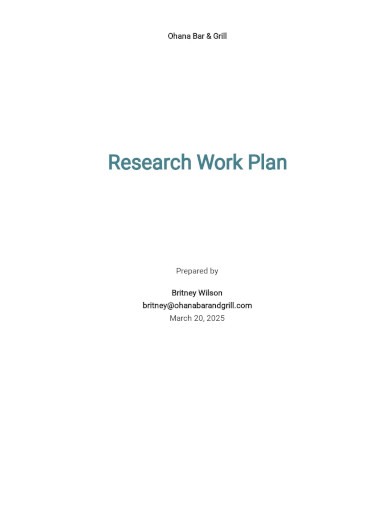
Free Research Work Plan Template
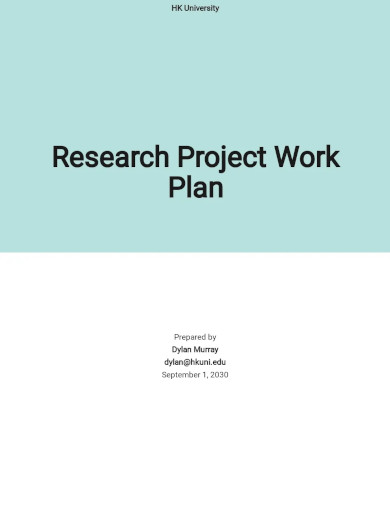
Research Project Work Plan Template
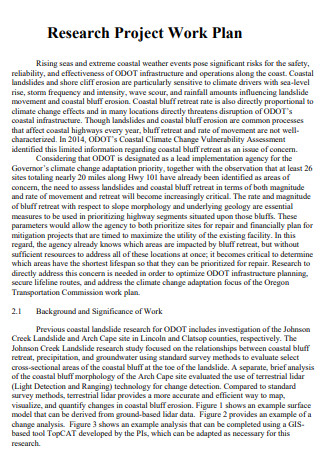
Research Project Work Plan
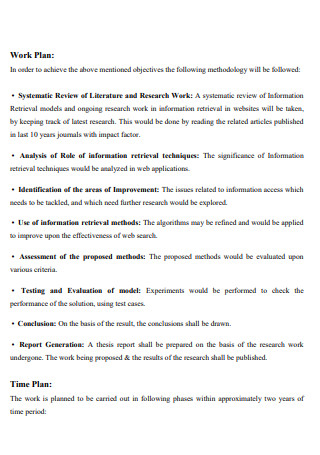
Research Work Plan
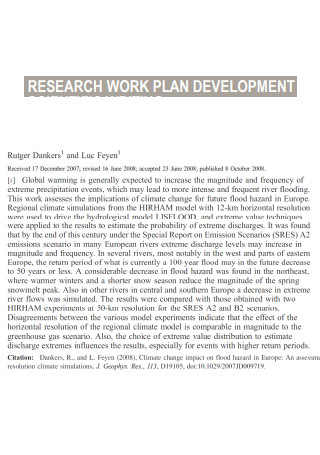
Research Work Plan Development
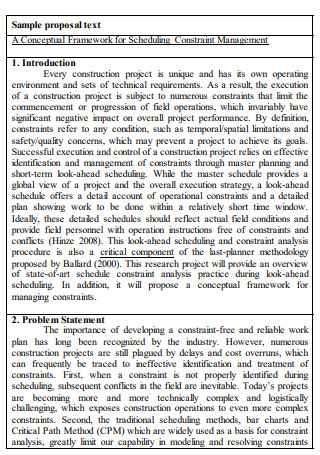
Sample Research Work Plan
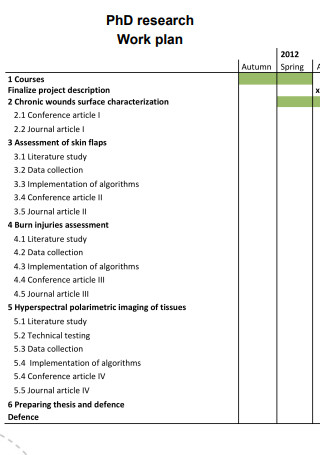
PhD Research Work Plan
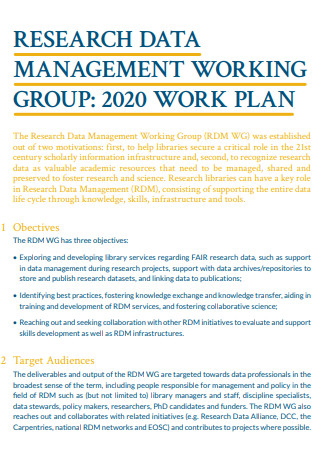
Research Data Management Work Plan
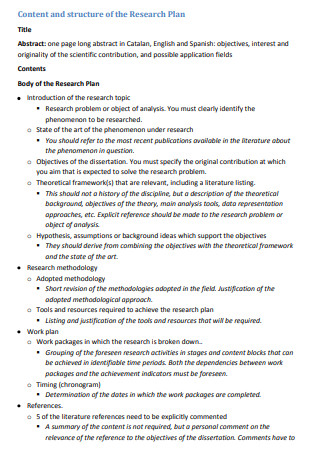
Structure of Research Work Plan

Research Work Action Plan
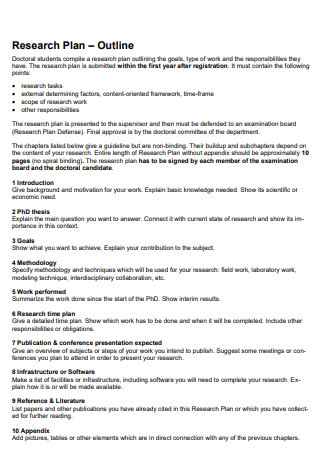
Research Work Plan Outline

Work Plan for Research Project
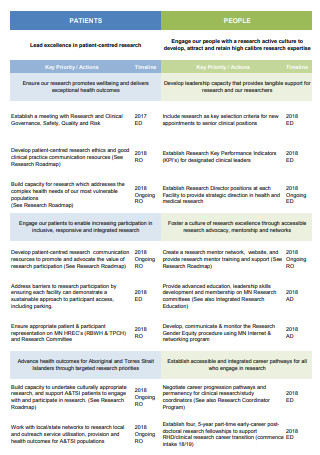
Transport Research Work Plan
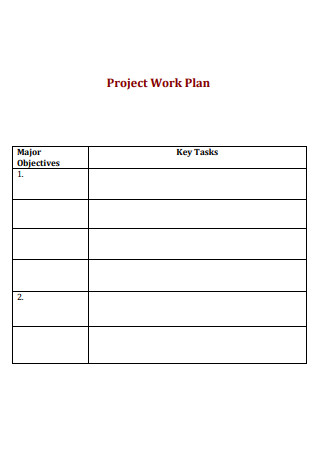
Monthly Project Research Work Plan
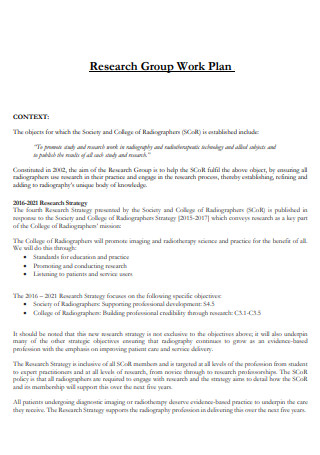
Research Work Group Plan
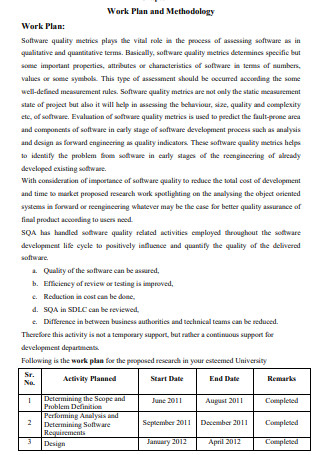

Research Work Plan and Methodology
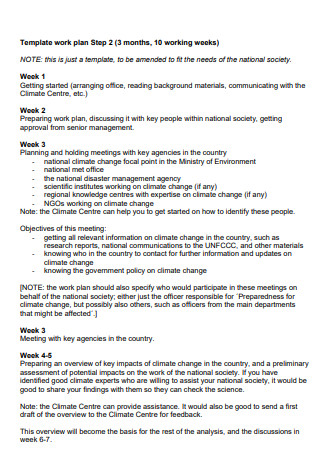
Half Yearly Research Work Plan
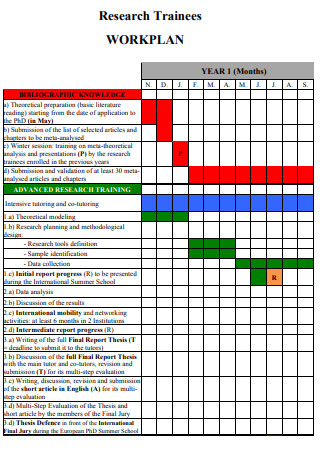
Research Trainee Work Plan

Research Team Work Plan
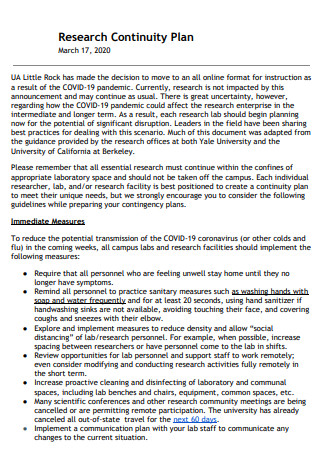
Research Work Continuity Plan
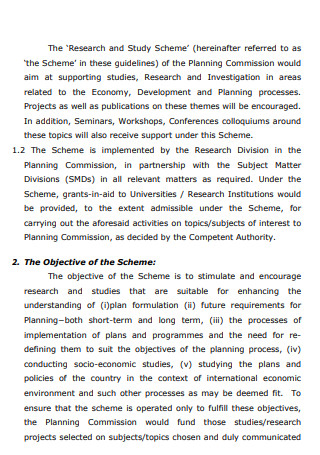
Simple Research Work Plan

Research Work Plan Project Proposal
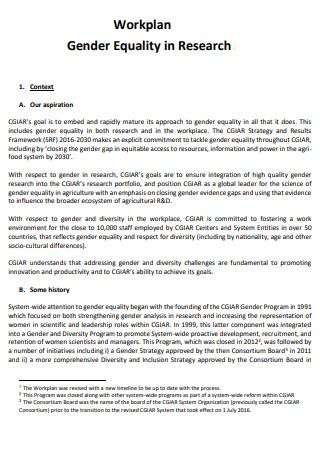
Gender Equality in Research Work Plan
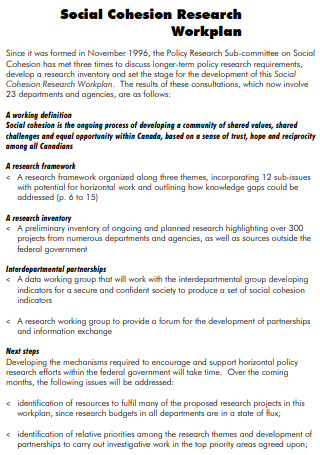
Social Cohesion Research Work Plan
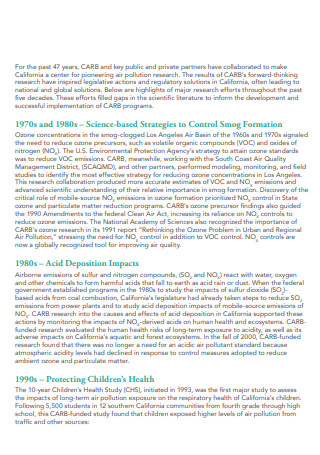
Strategic Research Work Plan
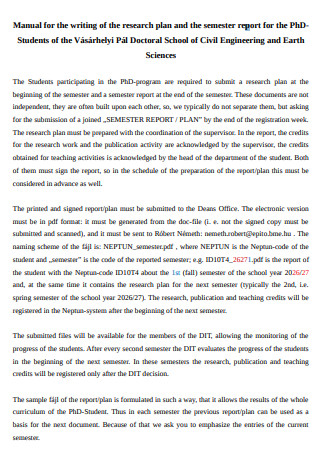
Formal Research Work Plan
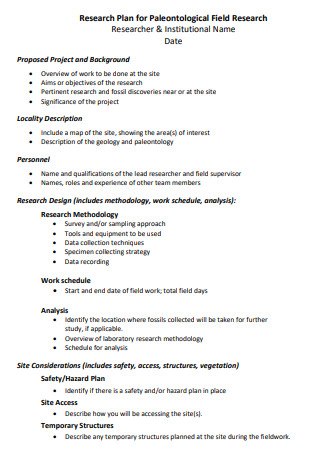
Field Research Work Plan
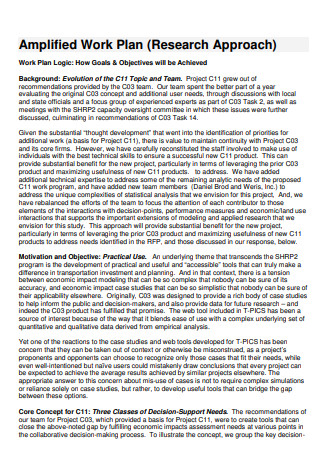
Research Amplified Work Plan
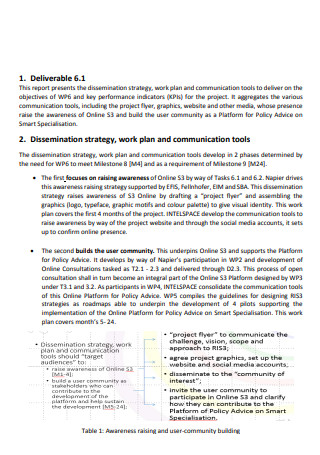
Basic Research Work Plan
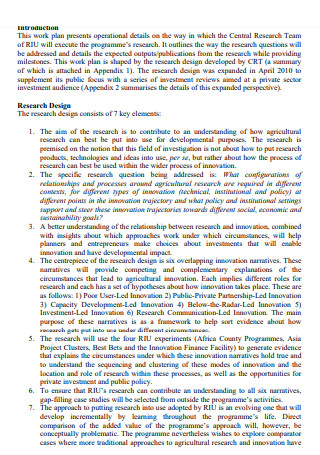
Central Research Team Work Plan
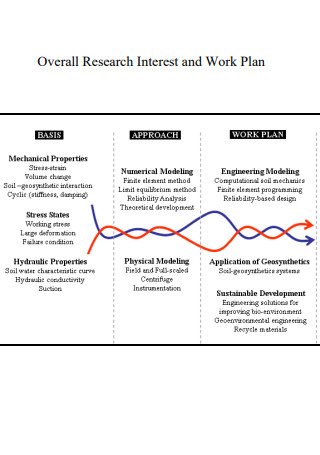
Research Interest and Work Plan
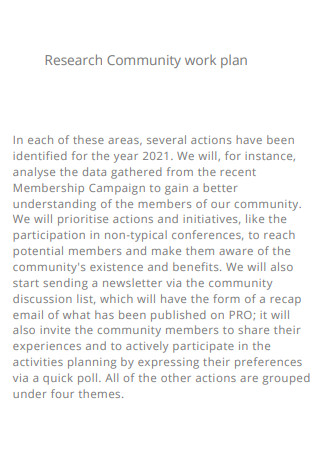
Research Community Work Plan
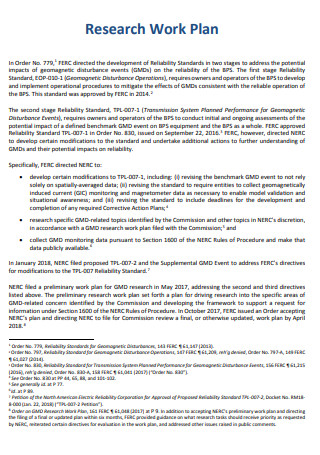
General Research Work Plan
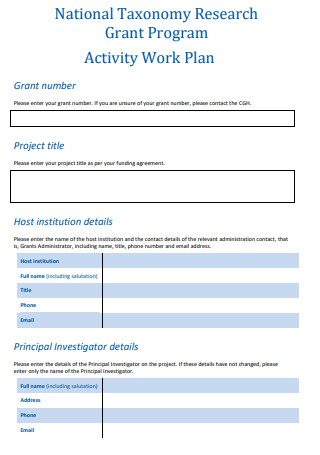
Research Activity Work Plan
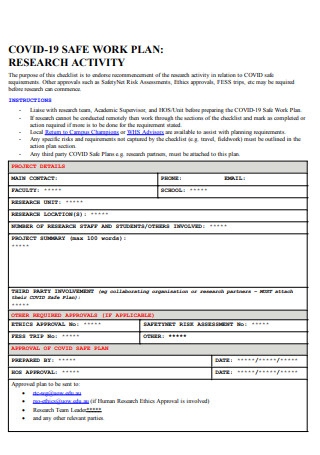
Research Safe Work Plan

Research Annual Work Plan
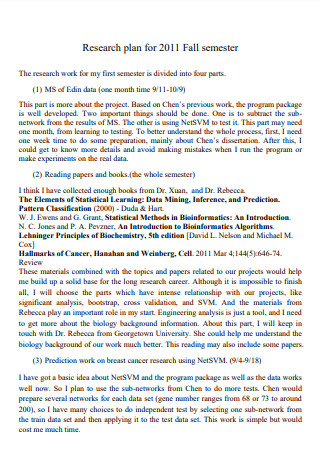
Research Work Plan Template
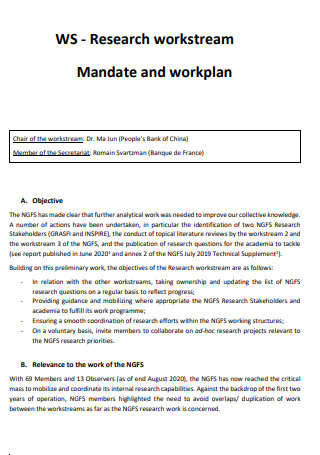
Research Mandate Work Plan
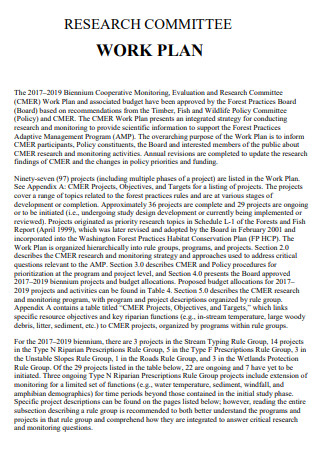
Research Commitee Work Plan
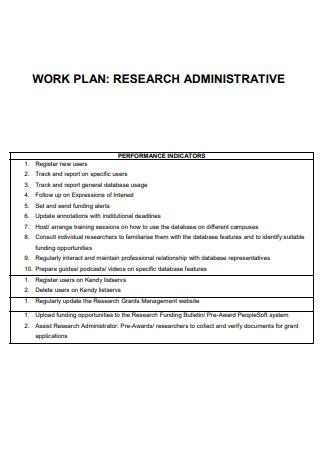
Research Administrative Work Plan
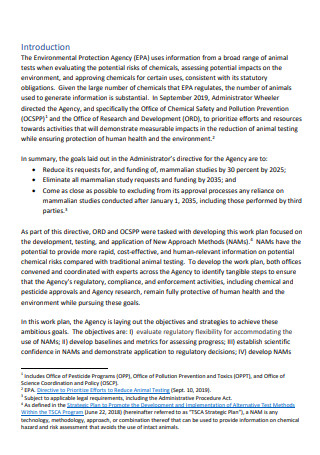
Research And Development Work Plan
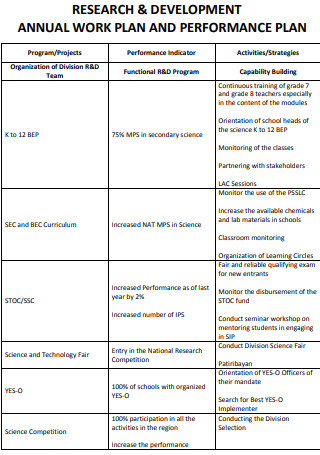
Research Work And Performance Plan

Research Project Work Plan Example
1. field research plan , 2. phd research work plan, 3. covid-19 safety research work plan, 4. social cohesion research work plan, step 1: develop the introduction, focus of research, goals and methodology, step 2: summarize the research work , step 3: set a research timeline , step 4: add other details, step 5: proofread and prepare the overall plan, share this post on your network, file formats, word templates, google docs templates, excel templates, powerpoint templates, google sheets templates, google slides templates, pdf templates, publisher templates, psd templates, indesign templates, illustrator templates, pages templates, keynote templates, numbers templates, outlook templates, you may also like these articles, 5+ sample investment company business plan in pdf.

What do you do when you have tons of spare cash lying around your home or burning a hole in your wallet or expensive jeans pocket? For some people, the…
41+ SAMPLE Unit Plan Templates in PDF | MS Word

As a teacher, you might know about every school policy, the steps to keep classrooms safe for intellectual development, how to set up an organized classroom, and the proposed…
browse by categories
- Questionnaire
- Description
- Reconciliation
- Certificate
- Spreadsheet
Information
- privacy policy
- Terms & Conditions

- Research Process
Writing a Scientific Research Project Proposal
- 5 minute read
- 98.2K views
Table of Contents
The importance of a well-written research proposal cannot be underestimated. Your research really is only as good as your proposal. A poorly written, or poorly conceived research proposal will doom even an otherwise worthy project. On the other hand, a well-written, high-quality proposal will increase your chances for success.
In this article, we’ll outline the basics of writing an effective scientific research proposal, including the differences between research proposals, grants and cover letters. We’ll also touch on common mistakes made when submitting research proposals, as well as a simple example or template that you can follow.
What is a scientific research proposal?
The main purpose of a scientific research proposal is to convince your audience that your project is worthwhile, and that you have the expertise and wherewithal to complete it. The elements of an effective research proposal mirror those of the research process itself, which we’ll outline below. Essentially, the research proposal should include enough information for the reader to determine if your proposed study is worth pursuing.
It is not an uncommon misunderstanding to think that a research proposal and a cover letter are the same things. However, they are different. The main difference between a research proposal vs cover letter content is distinct. Whereas the research proposal summarizes the proposal for future research, the cover letter connects you to the research, and how you are the right person to complete the proposed research.
There is also sometimes confusion around a research proposal vs grant application. Whereas a research proposal is a statement of intent, related to answering a research question, a grant application is a specific request for funding to complete the research proposed. Of course, there are elements of overlap between the two documents; it’s the purpose of the document that defines one or the other.
Scientific Research Proposal Format
Although there is no one way to write a scientific research proposal, there are specific guidelines. A lot depends on which journal you’re submitting your research proposal to, so you may need to follow their scientific research proposal template.
In general, however, there are fairly universal sections to every scientific research proposal. These include:
- Title: Make sure the title of your proposal is descriptive and concise. Make it catch and informative at the same time, avoiding dry phrases like, “An investigation…” Your title should pique the interest of the reader.
- Abstract: This is a brief (300-500 words) summary that includes the research question, your rationale for the study, and any applicable hypothesis. You should also include a brief description of your methodology, including procedures, samples, instruments, etc.
- Introduction: The opening paragraph of your research proposal is, perhaps, the most important. Here you want to introduce the research problem in a creative way, and demonstrate your understanding of the need for the research. You want the reader to think that your proposed research is current, important and relevant.
- Background: Include a brief history of the topic and link it to a contemporary context to show its relevance for today. Identify key researchers and institutions also looking at the problem
- Literature Review: This is the section that may take the longest amount of time to assemble. Here you want to synthesize prior research, and place your proposed research into the larger picture of what’s been studied in the past. You want to show your reader that your work is original, and adds to the current knowledge.
- Research Design and Methodology: This section should be very clearly and logically written and organized. You are letting your reader know that you know what you are going to do, and how. The reader should feel confident that you have the skills and knowledge needed to get the project done.
- Preliminary Implications: Here you’ll be outlining how you anticipate your research will extend current knowledge in your field. You might also want to discuss how your findings will impact future research needs.
- Conclusion: This section reinforces the significance and importance of your proposed research, and summarizes the entire proposal.
- References/Citations: Of course, you need to include a full and accurate list of any and all sources you used to write your research proposal.
Common Mistakes in Writing a Scientific Research Project Proposal
Remember, the best research proposal can be rejected if it’s not well written or is ill-conceived. The most common mistakes made include:
- Not providing the proper context for your research question or the problem
- Failing to reference landmark/key studies
- Losing focus of the research question or problem
- Not accurately presenting contributions by other researchers and institutions
- Incompletely developing a persuasive argument for the research that is being proposed
- Misplaced attention on minor points and/or not enough detail on major issues
- Sloppy, low-quality writing without effective logic and flow
- Incorrect or lapses in references and citations, and/or references not in proper format
- The proposal is too long – or too short
Scientific Research Proposal Example
There are countless examples that you can find for successful research proposals. In addition, you can also find examples of unsuccessful research proposals. Search for successful research proposals in your field, and even for your target journal, to get a good idea on what specifically your audience may be looking for.
While there’s no one example that will show you everything you need to know, looking at a few will give you a good idea of what you need to include in your own research proposal. Talk, also, to colleagues in your field, especially if you are a student or a new researcher. We can often learn from the mistakes of others. The more prepared and knowledgeable you are prior to writing your research proposal, the more likely you are to succeed.
Language Editing Services
One of the top reasons scientific research proposals are rejected is due to poor logic and flow. Check out our Language Editing Services to ensure a great proposal , that’s clear and concise, and properly referenced. Check our video for more information, and get started today.

- Manuscript Review
Research Fraud: Falsification and Fabrication in Research Data

Research Team Structure
You may also like.

Descriptive Research Design and Its Myriad Uses

Five Common Mistakes to Avoid When Writing a Biomedical Research Paper

Making Technical Writing in Environmental Engineering Accessible

To Err is Not Human: The Dangers of AI-assisted Academic Writing

When Data Speak, Listen: Importance of Data Collection and Analysis Methods

Choosing the Right Research Methodology: A Guide for Researchers

Why is data validation important in research?

Writing a good review article
Input your search keywords and press Enter.
What (Exactly) Is A Research Proposal?
A simple explainer with examples + free template.
By: Derek Jansen (MBA) | Reviewed By: Dr Eunice Rautenbach | June 2020 (Updated April 2023)
Whether you’re nearing the end of your degree and your dissertation is on the horizon, or you’re planning to apply for a PhD program, chances are you’ll need to craft a convincing research proposal . If you’re on this page, you’re probably unsure exactly what the research proposal is all about. Well, you’ve come to the right place.
Overview: Research Proposal Basics
- What a research proposal is
- What a research proposal needs to cover
- How to structure your research proposal
- Example /sample proposals
- Proposal writing FAQs
- Key takeaways & additional resources
What is a research proposal?
Simply put, a research proposal is a structured, formal document that explains what you plan to research (your research topic), why it’s worth researching (your justification), and how you plan to investigate it (your methodology).
The purpose of the research proposal (its job, so to speak) is to convince your research supervisor, committee or university that your research is suitable (for the requirements of the degree program) and manageable (given the time and resource constraints you will face).
The most important word here is “ convince ” – in other words, your research proposal needs to sell your research idea (to whoever is going to approve it). If it doesn’t convince them (of its suitability and manageability), you’ll need to revise and resubmit . This will cost you valuable time, which will either delay the start of your research or eat into its time allowance (which is bad news).

What goes into a research proposal?
A good dissertation or thesis proposal needs to cover the “ what “, “ why ” and” how ” of the proposed study. Let’s look at each of these attributes in a little more detail:
Your proposal needs to clearly articulate your research topic . This needs to be specific and unambiguous . Your research topic should make it clear exactly what you plan to research and in what context. Here’s an example of a well-articulated research topic:
An investigation into the factors which impact female Generation Y consumer’s likelihood to promote a specific makeup brand to their peers: a British context
As you can see, this topic is extremely clear. From this one line we can see exactly:
- What’s being investigated – factors that make people promote or advocate for a brand of a specific makeup brand
- Who it involves – female Gen-Y consumers
- In what context – the United Kingdom
So, make sure that your research proposal provides a detailed explanation of your research topic . If possible, also briefly outline your research aims and objectives , and perhaps even your research questions (although in some cases you’ll only develop these at a later stage). Needless to say, don’t start writing your proposal until you have a clear topic in mind , or you’ll end up waffling and your research proposal will suffer as a result of this.
Need a helping hand?
As we touched on earlier, it’s not good enough to simply propose a research topic – you need to justify why your topic is original . In other words, what makes it unique ? What gap in the current literature does it fill? If it’s simply a rehash of the existing research, it’s probably not going to get approval – it needs to be fresh.
But, originality alone is not enough. Once you’ve ticked that box, you also need to justify why your proposed topic is important . In other words, what value will it add to the world if you achieve your research aims?
As an example, let’s look at the sample research topic we mentioned earlier (factors impacting brand advocacy). In this case, if the research could uncover relevant factors, these findings would be very useful to marketers in the cosmetics industry, and would, therefore, have commercial value . That is a clear justification for the research.
So, when you’re crafting your research proposal, remember that it’s not enough for a topic to simply be unique. It needs to be useful and value-creating – and you need to convey that value in your proposal. If you’re struggling to find a research topic that makes the cut, watch our video covering how to find a research topic .

It’s all good and well to have a great topic that’s original and valuable, but you’re not going to convince anyone to approve it without discussing the practicalities – in other words:
- How will you actually undertake your research (i.e., your methodology)?
- Is your research methodology appropriate given your research aims?
- Is your approach manageable given your constraints (time, money, etc.)?
While it’s generally not expected that you’ll have a fully fleshed-out methodology at the proposal stage, you’ll likely still need to provide a high-level overview of your research methodology . Here are some important questions you’ll need to address in your research proposal:
- Will you take a qualitative , quantitative or mixed -method approach?
- What sampling strategy will you adopt?
- How will you collect your data (e.g., interviews, surveys, etc)?
- How will you analyse your data (e.g., descriptive and inferential statistics , content analysis, discourse analysis, etc, .)?
- What potential limitations will your methodology carry?
So, be sure to give some thought to the practicalities of your research and have at least a basic methodological plan before you start writing up your proposal. If this all sounds rather intimidating, the video below provides a good introduction to research methodology and the key choices you’ll need to make.
How To Structure A Research Proposal
Now that we’ve covered the key points that need to be addressed in a proposal, you may be wondering, “ But how is a research proposal structured? “.
While the exact structure and format required for a research proposal differs from university to university, there are four “essential ingredients” that commonly make up the structure of a research proposal:
- A rich introduction and background to the proposed research
- An initial literature review covering the existing research
- An overview of the proposed research methodology
- A discussion regarding the practicalities (project plans, timelines, etc.)
In the video below, we unpack each of these four sections, step by step.
Research Proposal Examples/Samples
In the video below, we provide a detailed walkthrough of two successful research proposals (Master’s and PhD-level), as well as our popular free proposal template.
Proposal Writing FAQs
How long should a research proposal be.
This varies tremendously, depending on the university, the field of study (e.g., social sciences vs natural sciences), and the level of the degree (e.g. undergraduate, Masters or PhD) – so it’s always best to check with your university what their specific requirements are before you start planning your proposal.
As a rough guide, a formal research proposal at Masters-level often ranges between 2000-3000 words, while a PhD-level proposal can be far more detailed, ranging from 5000-8000 words. In some cases, a rough outline of the topic is all that’s needed, while in other cases, universities expect a very detailed proposal that essentially forms the first three chapters of the dissertation or thesis.
The takeaway – be sure to check with your institution before you start writing.
How do I choose a topic for my research proposal?
Finding a good research topic is a process that involves multiple steps. We cover the topic ideation process in this video post.
How do I write a literature review for my proposal?
While you typically won’t need a comprehensive literature review at the proposal stage, you still need to demonstrate that you’re familiar with the key literature and are able to synthesise it. We explain the literature review process here.
How do I create a timeline and budget for my proposal?
We explain how to craft a project plan/timeline and budget in Research Proposal Bootcamp .
Which referencing format should I use in my research proposal?
The expectations and requirements regarding formatting and referencing vary from institution to institution. Therefore, you’ll need to check this information with your university.
What common proposal writing mistakes do I need to look out for?
We’ve create a video post about some of the most common mistakes students make when writing a proposal – you can access that here . If you’re short on time, here’s a quick summary:
- The research topic is too broad (or just poorly articulated).
- The research aims, objectives and questions don’t align.
- The research topic is not well justified.
- The study has a weak theoretical foundation.
- The research design is not well articulated well enough.
- Poor writing and sloppy presentation.
- Poor project planning and risk management.
- Not following the university’s specific criteria.
Key Takeaways & Additional Resources
As you write up your research proposal, remember the all-important core purpose: to convince . Your research proposal needs to sell your study in terms of suitability and viability. So, focus on crafting a convincing narrative to ensure a strong proposal.
At the same time, pay close attention to your university’s requirements. While we’ve covered the essentials here, every institution has its own set of expectations and it’s essential that you follow these to maximise your chances of approval.
By the way, we’ve got plenty more resources to help you fast-track your research proposal. Here are some of our most popular resources to get you started:
- Proposal Writing 101 : A Introductory Webinar
- Research Proposal Bootcamp : The Ultimate Online Course
- Template : A basic template to help you craft your proposal
If you’re looking for 1-on-1 support with your research proposal, be sure to check out our private coaching service , where we hold your hand through the proposal development process (and the entire research journey), step by step.

Psst… there’s more!
This post is an extract from our bestselling short course, Research Proposal Bootcamp . If you want to work smart, you don't want to miss this .
You Might Also Like:

51 Comments
I truly enjoyed this video, as it was eye-opening to what I have to do in the preparation of preparing a Research proposal.
I would be interested in getting some coaching.
I real appreciate on your elaboration on how to develop research proposal,the video explains each steps clearly.
Thank you for the video. It really assisted me and my niece. I am a PhD candidate and she is an undergraduate student. It is at times, very difficult to guide a family member but with this video, my job is done.
In view of the above, I welcome more coaching.
Wonderful guidelines, thanks
This is very helpful. Would love to continue even as I prepare for starting my masters next year.
Thanks for the work done, the text was helpful to me
Bundle of thanks to you for the research proposal guide it was really good and useful if it is possible please send me the sample of research proposal
You’re most welcome. We don’t have any research proposals that we can share (the students own the intellectual property), but you might find our research proposal template useful: https://gradcoach.com/research-proposal-template/
Cheruiyot Moses Kipyegon
Thanks alot. It was an eye opener that came timely enough before my imminent proposal defense. Thanks, again
thank you very much your lesson is very interested may God be with you
I am an undergraduate student (First Degree) preparing to write my project,this video and explanation had shed more light to me thanks for your efforts keep it up.
Very useful. I am grateful.
this is a very a good guidance on research proposal, for sure i have learnt something
Wonderful guidelines for writing a research proposal, I am a student of m.phil( education), this guideline is suitable for me. Thanks
You’re welcome 🙂
Thank you, this was so helpful.
A really great and insightful video. It opened my eyes as to how to write a research paper. I would like to receive more guidance for writing my research paper from your esteemed faculty.
Thank you, great insights
Thank you, great insights, thank you so much, feeling edified
Wow thank you, great insights, thanks a lot
Thank you. This is a great insight. I am a student preparing for a PhD program. I am requested to write my Research Proposal as part of what I am required to submit before my unconditional admission. I am grateful having listened to this video which will go a long way in helping me to actually choose a topic of interest and not just any topic as well as to narrow down the topic and be specific about it. I indeed need more of this especially as am trying to choose a topic suitable for a DBA am about embarking on. Thank you once more. The video is indeed helpful.
Have learnt a lot just at the right time. Thank you so much.
thank you very much ,because have learn a lot things concerning research proposal and be blessed u for your time that you providing to help us
Hi. For my MSc medical education research, please evaluate this topic for me: Training Needs Assessment of Faculty in Medical Training Institutions in Kericho and Bomet Counties
I have really learnt a lot based on research proposal and it’s formulation
Thank you. I learn much from the proposal since it is applied
Your effort is much appreciated – you have good articulation.
You have good articulation.
I do applaud your simplified method of explaining the subject matter, which indeed has broaden my understanding of the subject matter. Definitely this would enable me writing a sellable research proposal.
This really helping
Great! I liked your tutoring on how to find a research topic and how to write a research proposal. Precise and concise. Thank you very much. Will certainly share this with my students. Research made simple indeed.
Thank you very much. I an now assist my students effectively.
Thank you very much. I can now assist my students effectively.
I need any research proposal
Thank you for these videos. I will need chapter by chapter assistance in writing my MSc dissertation
Very helpfull
the videos are very good and straight forward
thanks so much for this wonderful presentations, i really enjoyed it to the fullest wish to learn more from you
Thank you very much. I learned a lot from your lecture.
I really enjoy the in-depth knowledge on research proposal you have given. me. You have indeed broaden my understanding and skills. Thank you
interesting session this has equipped me with knowledge as i head for exams in an hour’s time, am sure i get A++
This article was most informative and easy to understand. I now have a good idea of how to write my research proposal.
Thank you very much.
Wow, this literature is very resourceful and interesting to read. I enjoyed it and I intend reading it every now then.
Thank you for the clarity
Thank you. Very helpful.
Thank you very much for this essential piece. I need 1o1 coaching, unfortunately, your service is not available in my country. Anyways, a very important eye-opener. I really enjoyed it. A thumb up to Gradcoach
What is JAM? Please explain.
Thank you so much for these videos. They are extremely helpful! God bless!
very very wonderful…
thank you for the video but i need a written example
Submit a Comment Cancel reply
Your email address will not be published. Required fields are marked *
Save my name, email, and website in this browser for the next time I comment.
- Print Friendly

The scope of work should include the following sections: (1) introduction, (2) statement of objectives, (3) materials and methods, (4) expected results/format of report, and (5) literature citations. Your submitted scope of work should include the following:
1. The Cover Sheet . The cover sheet must include the tentative title, date, author(s), and MP advisor(s). The cover sheet must also include the author(s) and advisor(s) signature(s) to demonstrate faculty approval (Visit #1 on the Final Report page for more information on Cover Sheets or download the template ). 2. Introduction . Describe the problem you will be working on and why it is important. Include a concise literature review to relate your problem to previous work and set the stage for the approach you will take. If applicable, describe the client involved and their interest in the project. [2-4 pages] 3. Objectives . State the research questions your MP will answer or the hypotheses you will test. Be specific and succinct. You should be able to list your questions or hypotheses as a series of no more than 3 or 4 concrete bullet points. While you may fine-tune these questions after you begin your work, the initial description of your methods and expected results should follow directly from these objectives. [<1 page] 4. Methods and Sources of Support . Describe the methods/approach you plan to use including, as appropriate, your research approach, data or means of data collection, and plans for data analysis. Be specific and identify significant subtasks related to each part of your project. State any research support needed in terms of supplies, space, equipment and money. If needed, identify source(s) of financial support (e.g., case study funds, research project of professor, school support, grant, etc.). Note whether you will require Institutional Review Board (IRB) approval for data collection involving human subjects, or whether you will operate under a nondisclosure agreement . [2-3 pages] 5. Expected Results and Format of Report . Identify the expected results of the project and/or the deliverables to be produced (e.g., management plan, geospatial tool, scientific publication, policy recommendations, computer model, etc.). State the format of the final product and its intended audience. If appropriate, identify likely journals for publication of your research. [1-2 pages] 6. Literary Citations . Include full, standard citations for any references referred to in the text of your proposal. The Nicholas School does not require MPs to adhere to one specific citation style as long as citations are formatted consistently throughout the final document. Choose the appropriate manual of style for your project (for guidance, see Duke Libraries citation resources ). 7. Faculty . List all faculty who have agreed to serve as advisors or cooperators in your project, along with their affiliations (e.g., school or department). Indicate the primary adviser(s) responsible for evaluating the project.
Part II: Project Timeline
Part two should contain the timeline with anticipated deliverables, and may be attached as a separate document, if using Excel or other project management formats. Timeline of Tasks, Deliverables, and Events . Outline the various steps of project completion from start to finish. Include all significant milestones and recurring meetings with your teammates (if applicable) and MP advisor. For example, this could include completion of your literature review and other background research, as well as intermediate steps related to your data collection and planned analysis. It is highly recommended that you use a Gantt chart or an equivalent Excel spreadsheet (e.g. with individual tasks and milestones as rows and dates in columns), with ongoing tasks specified at a biweekly resolution. Your timeline should also include standing client meetings, if relevant.
Part III: Team Charter
The team charter should outline roles and responsibilities of the team and advisor. All students, including those completing an individual MPs, must include a team charter in the final Work Plan. If you are participating in an individual project, you and your MP advisor are considered a “team”.
Your team charter should include the following: 1. Team Roles and Responsibilities . Assign each team member a role and associated responsibilities to be fulfilled during completion of the MP. 2. Regular Meeting Schedule. Outline how often, in what way, and with whom your MP team will meet. This includes regular team meetings, as well as standing meetings with your advisor and, if relevant, client. Frequency and content of the meetings is up to the collective discretion of the team. 3. Team Expectations . Describe any additional agreements your MP team comes up with. (e.g., how to handle potential conflicts, preferred means of communication, data sharing and storage, etc.) 4. Team Purpose and Mission . Describe the top priorities and goals of each individual team member during the course of the project. 5. Team Cohesion and Conflict Resolution. Include a brief description that addresses these questions: How will your team resolve conflict? How can you most effectively handle scenarios in which team members are not pulling their weight or not living up to the expectations outlined in this charter? How will you have difficult conversations? What steps will you take to understand and know each other better? How do you want to promote ongoing integration and camaraderie within the team?
Site Login >
- Postgraduate
Research degrees
- Examples of Research proposals
- Apply for 2024
- Find a course
- Accessibility
Examples of research proposals
How to write your research proposal, with examples of good proposals.
Research proposals
Your research proposal is a key part of your application. It tells us about the question you want to answer through your research. It is a chance for you to show your knowledge of the subject area and tell us about the methods you want to use.
We use your research proposal to match you with a supervisor or team of supervisors.
In your proposal, please tell us if you have an interest in the work of a specific academic at York St John. You can get in touch with this academic to discuss your proposal. You can also speak to one of our Research Leads. There is a list of our Research Leads on the Apply page.
When you write your proposal you need to:
- Highlight how it is original or significant
- Explain how it will develop or challenge current knowledge of your subject
- Identify the importance of your research
- Show why you are the right person to do this research
- Research Proposal Example 1 (DOC, 49kB)
- Research Proposal Example 2 (DOC, 0.9MB)
- Research Proposal Example 3 (DOC, 55.5kB)
- Research Proposal Example 4 (DOC, 49.5kB)
Subject specific guidance
- Writing a Humanities PhD Proposal (PDF, 0.1MB)
- Writing a Creative Writing PhD Proposal (PDF, 0.1MB)
- About the University
- Our culture and values
- Academic schools
- Academic dates
- Press office
Our wider work
- Business support
- Work in the community
- Donate or support
Connect with us
York St John University
Lord Mayor’s Walk
01904 624 624
York St John London Campus
6th Floor Export Building
1 Clove Crescent
01904 876 944

- Policies and documents
- Module documents
- Programme specifications
- Quality gateway
- Admissions documents
- Access and Participation Plan
- Freedom of information
- Accessibility statement
- Modern slavery and human trafficking statement
© York St John University 2024
Colour Picker
Lorem ipsum dolor sit amet, consectetur adipiscing elit, sed do eiusmod tempor incididunt ut labore et dolore magna aliqua. Dui id ornare arcu odio.
Felis bibendum ut tristique et egestas quis ipsum. Et netus et malesuada fames ac turpis egestas. Faucibus pulvinar elementum integer enim neque volutpat ac. Hac habitasse platea dictumst vestibulum rhoncus.
Nec ullamcorper sit amet risus nullam eget felis eget. Eget felis eget nunc lobortis mattis aliquam faucibus purus.
All Formats
Table of Contents
Plan template bundle, what is a research work plan, what is the difference between a research plan and a research proposal, what is the purpose of a research plan, what are the good research questions, what are the components of a work plan, free 12+ research work plan templates in pdf | ms word, 1. research work plan format template, 2. research project communication plan template, 3. free project research work plan template, 4. free research work plan example, 5. free research work group plan template, 6. half yearly research work plan template, 7. sample research work plan template, 8. free research work plan template in pdf, 9. free business research work plan template, 10. free project research work plan example, 11. monthly project research work plan template, 12. transport research work plan template, 13. free research work plan template in doc, how to develop a work plan, advantages of developing a work plan, plan templates, 12+ research work plan templates in pdf | ms word.
A work plan is an overview of a series of objectives and procedures by which a team and/or entity can achieve those goals and provide the reader with a clearer picture of the project’s context. No matter if it is used in professional or academic life, work plans serve the purpose of helping you stay focused when working on a certain project. You disintegrate a process into tiny, manageable tasks by work schedules , and define the tasks you want to achieve.
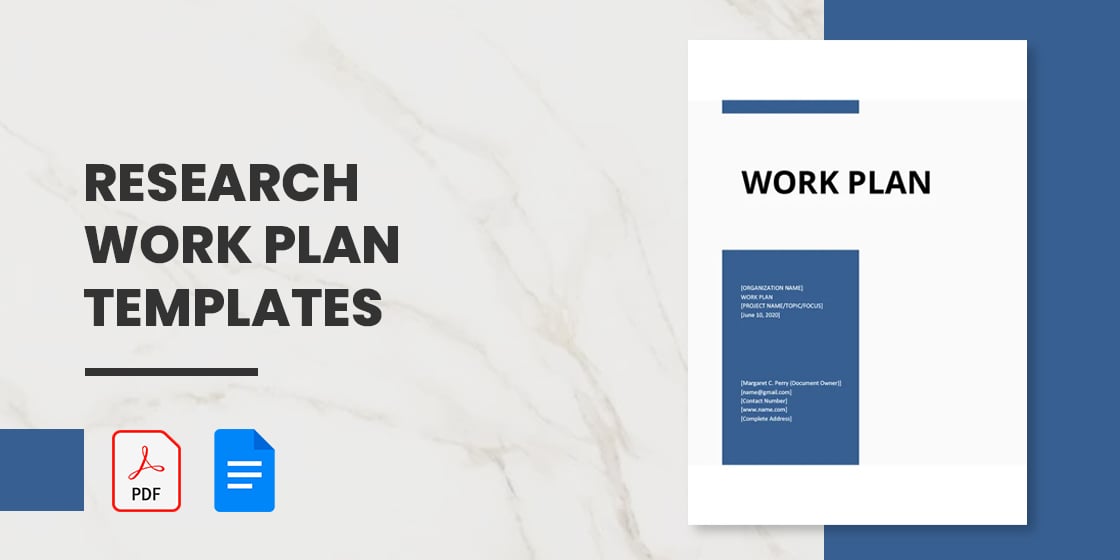
- Google Docs

- Apple Pages

Step 1: Think About the Objectives
Step 2: introduction and background, step 3: list the resources, step 4: anticipate and define limitations, step 5: assign roles, step 6: write the strategy, determine goals and objectives, organize teams and leadership, establish project timelines, set project budget, quality assurance and control, more in plan templates, editable research flowchart template, research poster template for keynote, education research agenda template, research agenda template, legal research methodology ppt template, medical research template, research template, high school research template, research proposal template, detailed financial research template.
- 7+ Financial Plan Templates
- 10+ Operational Plan Templates
- 9+ Training Plan Templates
- 5+ Shooting Schedule Template
- 11+ School Counselor Lesson Plan Templates in PDF | Word
- 9+ Interdisciplinary Lesson Plan Templates in PDF | MS Word
- 10+ Business Continuity Plan Templates in Google Docs | Ms Word | Pages | PDF
- 18+ Compensation Plan Templates in Google Docs | MS Word | Pages | PDF
- 10+ Executive Bonus Plan Templates in PDF
- 8+ Facility Management Plan Templates in PDF
- 10+ Diversity Recruitment Plan Templates in PDF | MS Word
- 11+ Audit Corrective Action Plan Templates in MS Word | Excel | PDF
- 9+ Recruitment Agency Marketing Plan Templates in PDF
- 10+ Recruitment Marketing Plan Templates in PDF | MS Word
- 10+ Student Recruitment Plan Templates in PDF | MS Word
File Formats
Word templates, google docs templates, excel templates, powerpoint templates, google sheets templates, google slides templates, pdf templates, publisher templates, psd templates, indesign templates, illustrator templates, pages templates, keynote templates, numbers templates, outlook templates.
- Sample Research
FREE 10+ Research Work Plan Samples in MS Word | PDF

Are you a novice researcher? If you are starting on your research project, there’s a possibility that you are under pressure to work efficiently with a great focus. To be a reliable researcher, you need to understand the nature and main purpose of research, the proper selection of research methods, and many more vital aspects. What are the things you need to do in writing a research work plan ? In this article, we have some downloadable plan samples to guide you. Keep on reading!
Research Work Plan
Free 10+ research work plan samples, 1. sample work plan for research project, 2. simple research plan template, 3. transport research work plan, 4. sample project research plan template, 5. project plan for research sample, 6. sample work plan template, 7. research work plan template, 8. research work plan outline sample, 9. formal work plan template, 10. sample research work group plan, 11. work plan and methodology template, what is a research work plan, how to write a research work plan, 1. brainstorm and develop your desired goals , 2. draft your introductory plan, 3. outline integral tasks and research strategies, 4. execute and revise your plan , what are the key elements of a research work plan, what is a good research plan, what are the steps of the research process, what is the content of a work plan.
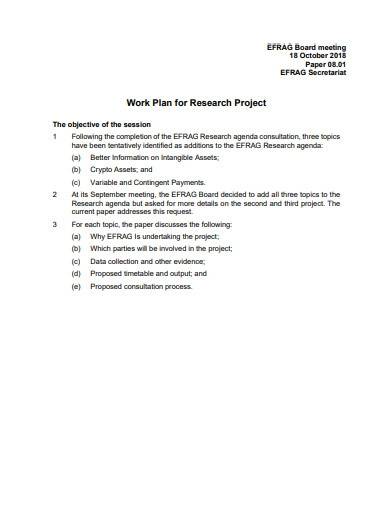
Size: 150 KB
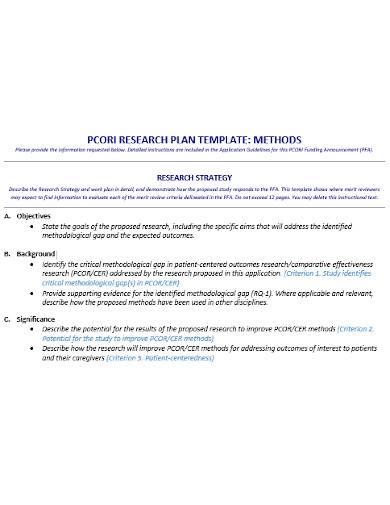
Size: 34 KB

Size: 171 KB
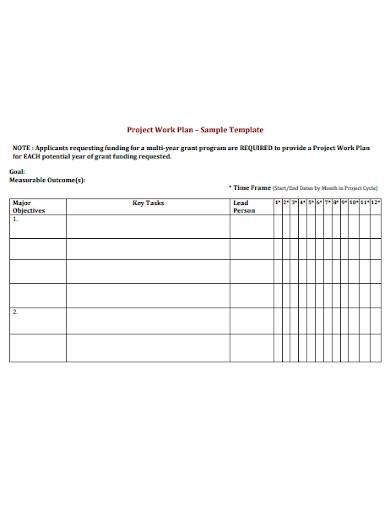
Size: 239 KB
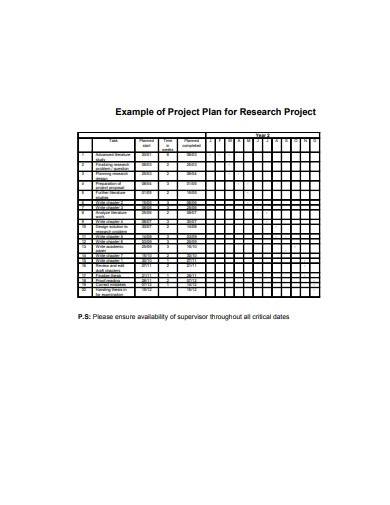
Size: 48 KB

Size: 35 KB

Size: 341 KB
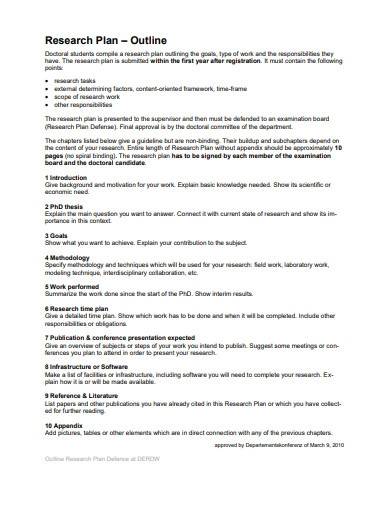
Size: 106 KB
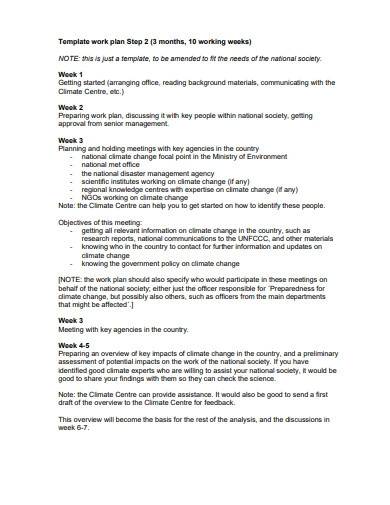
Size: 10 KB
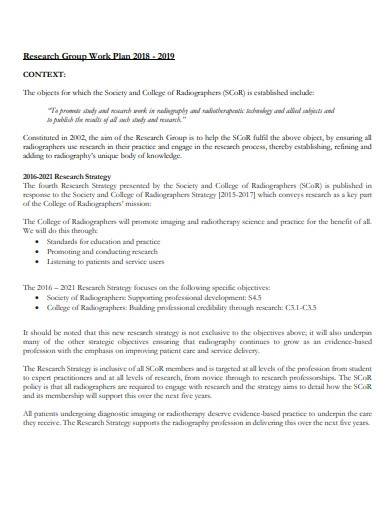
Size: 288 KB
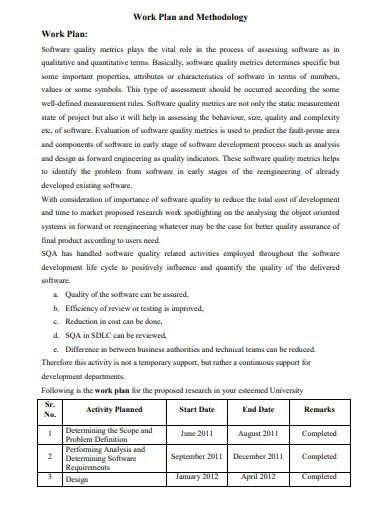
A research work plan is a fundamental document that defines initial ideas and concepts on a specific research project in a structured manner. This is a comprehensive guide that is used by professionals such as educators, scientists, medical practitioners, researchers, and many others in sharing their own thoughts to their peers and collaborators.
When writing a well-detailed plan, you need to be systematic when it comes to developing the subject of your research work by using your intellectual ability, critical analysis, etc. Below are some helpful tips in writing an effective plan :
What are your specific desired research goals, objectives and results? Brainstorm as you think deeper and obtain useful or interesting information while developing your goals and objectives. We suggest that you use some helpful guides such as categorization, explanation, prediction, creating a sense of understanding, evaluation, etc.
After establishing your research goals, you need to draft your introductory plan . This part of your plan acts like a rough sketch of your overall plan. Include some information about your research group or team that will be working together for your project . Simply, make a basic plan on what you will perform to accomplish your goals and succeed in your research work.
The third step is to outline the integral tasks that you need to include in your plan for your research project. Avoid doing some irrelevant things that may decrease your productivity and efficiency. Also, focus on utilizing research strategies such as exploration, testing and problem solving that are associated with your research goals and objectives. Carefully map out your tasks of your research process by using some charts, visual diagrams, and more.
Finally, you can now execute all the significant points for your plan . Make sure to consult or ask some help from your colleagues or other experts in your field as well in reviewing and revising your plan to avoid any misunderstandings on your part.
The key elements of a research work plan are significant definitions, the general approach, a literature review, conceptual frameworks, the research questions and hypothesis.
A good research plan should contain short and concise introduction to the research field, topic relevance, and different kinds of methods used to obtain results such as framework, new technical solutions, etc
The common steps of the research process are topic development, preliminary data research, material or resource location, data analysis, note-taking, and research paper production.
As a formal roadmap for a project, a work plan contains demonstrable objectives, well-detailed steps or methods, and measurable deliverables.
Dale Carnegie said “An hour of planning can save you 10 hours of doing.” Therefore, a comprehensive research work plan is a vital tool to guide you in fulfilling your research goals, objectives, and desired results, especially it saves you an enormous time and effort.To help you in this matter, here are some of our downloadable and printable action plan samples available in different kinds of formats. Simply click the templates in this article and start downloading now!
Related Posts
Free 50+ strategic planning samples in google docs | pages | pdf | ms word, free 10+ construction project plan samples in ms word | google docs | apple pages | pdf, free 10+ construction marketing business plan samples in ms word | google docs | pdf, free 17+ construction business continuity plan samples in ms word | google docs | pdf, free 11+ construction business development plan samples in ms word | google docs | pdf, free 20+ budget planning samples in pdf, free 20+ workout plan samples in ms word | google docs | pages | pdf, free 20+ lesson planning samples in pdf, free 14+ employee work plan templates in pdf | ms word, free 8+ sample weekly meal plan templates in pdf, free 17+ sample classroom management plan templates in pdf | ms word, free 13+ homework planner samples and templates in pdf | ms word, free 14+ leadership development plan samples in ms word | pages | google docs | pdf, free 15+ sample math lesson plan templates in pdf | ms word, free 11+ gym business plan templates in pdf | ms word, free 10+ market research plan samples & templates in ms word ..., free 23+ sample work plan templates in google docs ms word ..., free 11+ sample logic models in pdf ms word, free 30+ action plan format samples in ms word pdf.
Numbers, Facts and Trends Shaping Your World
Read our research on:
Full Topic List
Regions & Countries
- Publications
- Our Methods
- Short Reads
- Tools & Resources
Read Our Research On:
Key facts about U.S. immigration policies and Biden’s proposed changes
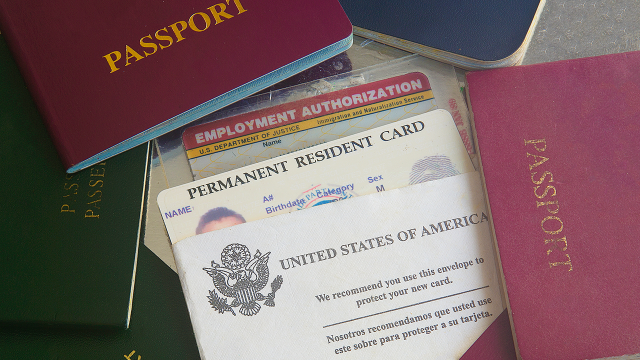
Since President Joe Biden took office in January 2021, his administration has acted on a number of fronts to reverse Trump-era restrictions on immigration to the United States. The steps include plans to boost refugee admissions , preserving deportation relief for unauthorized immigrants who came to the U.S. as children and not enforcing the “ public charge ” rule that denies green cards to immigrants who might use public benefits like Medicaid.
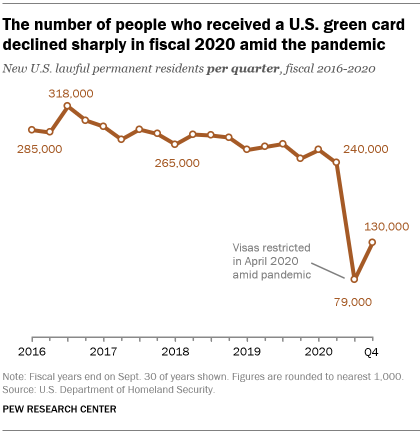
Biden has also lifted restrictions established early in the coronavirus pandemic that drastically reduced the number of visas issued to immigrants. The number of people who received a green card declined from about 240,000 in the second quarter of the 2020 fiscal year (January to March) to about 79,000 in the third quarter (April to June). By comparison, in the third quarter of fiscal 2019, nearly 266,000 people received a green card.
Biden’s biggest immigration proposal to date would allow more new immigrants into the U.S. while giving millions of unauthorized immigrants who are already in the country a pathway to legal status. The expansive legislation would create an eight-year path to citizenship for the nation’s estimated 10.5 million unauthorized immigrants , update the existing family-based immigration system, revise employment-based visa rules and increase the number of diversity visas . By contrast, President Donald Trump’s administration sought to restrict legal immigration in a variety of ways, including through legislation that would have overhauled the nation’s legal immigration system by sharply reducing family-based immigration.
The Biden administration has proposed legislation that would create new ways for immigrants to legally enter the United States. The bill would also create a path to citizenship for unauthorized immigrants living in the country.
To better understand the existing U.S. immigration system, we analyzed the most recent data available on federal immigration programs. This includes admission categories for green card recipients and the types of temporary employment visas available to immigrant workers. We also examined temporary permissions granted to some immigrants to live and work in the country through the Deferred Action for Childhood Arrivals and Temporary Protected Status programs.
This analysis relies on data from various sources within the U.S. government, including the Department of Homeland Security, Citizenship and Immigration Services, the Department of State, Federal Register announcements and public statements from the White House.
The Senate is considering several immigration provisions in a spending bill, the Build Back Better Act , that the House passed in November 2021. While passage of the bill is uncertain – as is the inclusion of immigration reforms in the bill’s final version – the legislation would make about 7 million unauthorized immigrants eligible to apply for protection from deportation, work permits and driver’s licenses.
Amid a record number of migrant encounters at the U.S.-Mexico border, Biden reinstated in December 2021 a Trump-era policy that requires those who arrive at the U.S.-Mexico border and seek asylum to wait in Mexico while their claims are processed. Biden had earlier ended the Migration Protection Protocols , or “Remain in Mexico” policy, and then restarted it after the U.S. Supreme Court upheld a lawsuit by Texas and Missouri that challenged the program’s closure. Asylum seekers do not receive a legal status that allows them to live and work in the U.S. until the claim is approved.
Overall, more than 35 million lawful immigrants live in the U.S.; most are American citizens. Many live and work in the country after being granted lawful permanent residence, while others receive temporary visas available to students and workers. In addition, roughly 1 million unauthorized immigrants have temporary permission to live and work in the U.S. through the Deferred Action for Childhood Arrivals and Temporary Protected Status programs.
Here are key details about existing U.S. immigration programs, as well as Biden’s proposed changes to them:
Family-based immigration
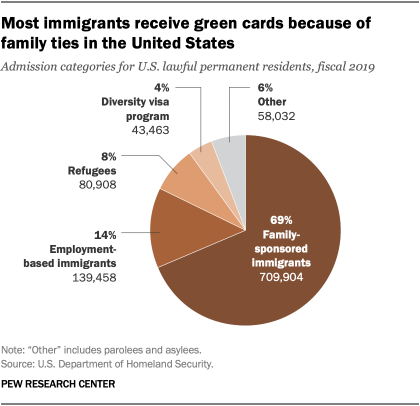
In fiscal 2019, nearly 710,000 people received lawful permanent residence in the U.S. through family sponsorship. The program allows someone to receive a green card if they already have a spouse, child, sibling or parent living in the country with U.S. citizenship or, in some cases, a green card. Immigrants from countries with large numbers of applicants often wait for years to receive a green card because a single country can account for no more than 7% of all green cards issued annually.
Biden’s proposal would expand access to family-based green cards in a variety of ways, such as by increasing per-country caps and clearing application backlogs. Today, family-based immigration – referred to by some as “ chain migration ” – is the most common way people gain green cards, in recent years accounting for about two-thirds of the more than 1 million people who receive green cards annually.
Refugee admissions
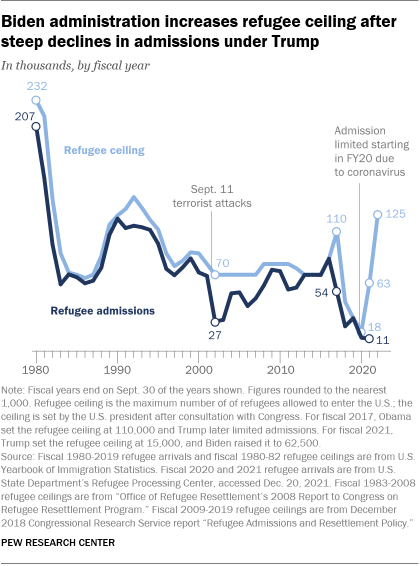
The U.S. admitted only 11,411 refugees in fiscal year 2021, the lowest number since Congress passed the 1980 Refugee Act for those fleeing persecution in their home countries. The low number of admissions came even after the Biden administration raised the maximum number of refugees the nation could admit to 62,500 in fiscal 2021 . Biden has increased the refugee cap to 125,000 for fiscal 2022, which started on Oct. 1, 2021.
The low number of admissions in recent years is due in part to the ongoing pandemic. The U.S. admitted only about 12,000 refugees in fiscal 2020 after the country suspended admissions during the coronavirus outbreak . This was down from nearly 54,000 in fiscal 2017 and far below the nearly 85,000 refugees admitted in fiscal 2016, the last full fiscal year of the Obama administration.
The recent decline in refugee admissions also reflects policy decisions made by the Trump administration before the pandemic. Trump capped refugee admissions in fiscal 2020 at 18,000 , the lowest total since Congress created the modern refugee program in 1980.
Employment-based green cards
In fiscal 2019, the U.S. government awarded more than 139,000 employment-based green cards to foreign workers and their families. The Biden administration’s proposed legislation could boost the number of employment-based green cards, which are capped at about 140,000 per year . The proposal would allow the use of unused visa slots from previous years and allow spouses and children of employment-based visa holders to receive green cards without counting them against the annual cap. These measures could help clear the large backlog of applicants. The proposed legislation also would eliminate the per-country cap that prevents immigrants from any single country to account for more than 7% of green cards issued each year.
Diversity visas
Each year, about 50,000 people receive green cards through the U.S. diversity visa program , also known as the visa lottery. Since the program began in 1995, more than 1 million immigrants have received green cards through the lottery, which seeks to diversify the U.S. immigrant population by granting visas to underrepresented nations. Citizens of countries with the most legal immigrant arrivals in recent years – such as Mexico, Canada, China and India – are not eligible to apply.
The Biden administration has proposed legislation to increase the annual total to 80,000 diversity visas. Trump had sought to eliminate the program .
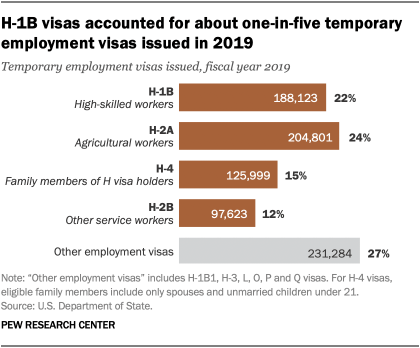
In fiscal 2019, more than 188,000 high-skilled foreign workers received H-1B visas . H-1B visas accounted for 22% of all temporary visas for employment issued in 2019. This trailed only the H-2A visa for agricultural workers, which accounted for nearly a quarter (24%) of temporary visas. In all, nearly 2 million H-1B visas were issued from fiscal years 2007 to 2019.
The Biden administration is expected to review policies that led to increased denial rate s of H-1B visa applications under the Trump administration. In addition, Biden has delayed implementing a rule put in place by Trump that sought to prioritize the H-1B visa selection process based on wages, which would have raised the wages of H-1B recipients overall. Biden also proposed legislation to provide permanent work permits to spouses of H-1B visa holders. By contrast, the Trump administration had sought to restrict these permits. The Trump administration also created an electronic registration system that led to a record number of applicants for fiscal 2021.
Temporary permissions
A relatively small number of unauthorized immigrants who came to the U.S. under unusual circumstances have received temporary legal permission to stay in the country. One key distinction for this group of immigrants is that, despite having received permission to live in the U.S., most don’t have a path to gain lawful permanent residence. The following two programs are examples of this:
Deferred Action for Childhood Arrivals
About 636,000 unauthorized immigrants had temporary work permits and protection from deportation through the Deferred Action for Childhood Arrivals program, or DACA, as of Dec. 31, 2020. One of Biden’s first actions as president was to direct the federal government to take steps to preserve the program , which Trump had tried to end before the Supreme Court allowed it to remain in place . DACA recipients, sometimes called “Dreamers,” would be among the undocumented immigrants to have a path to U.S. citizenship under Biden’s immigration bill. Senators have also proposed separate legislation that would do the same.
Temporary Protected Status
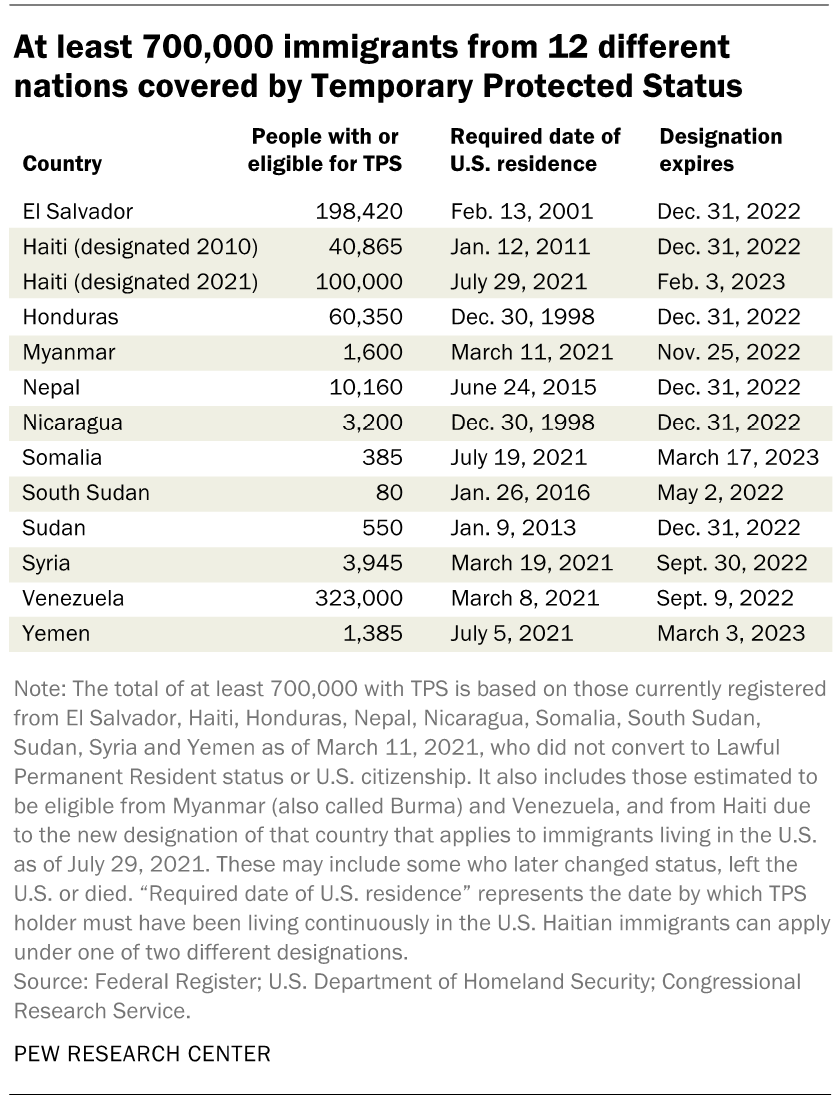
Overall, it is estimated that more than 700,000 immigrants from 12 countries currently have or are eligible for a reprieve from deportation under Temporary Protected Status, or TPS , a federal program that gives time-limited permission for some immigrants from certain countries to work and live in the U.S. The program covers those who fled designated nations because of war, hurricanes, earthquakes or other extraordinary conditions that could make it dangerous for them to live there.
The estimated total number of immigrants is based on those currently registered, in addition to those estimated to be eligible from Myanmar – also called Burma – and Venezuela.
Immigrants from Venezuela and Myanmar are newly eligible for TPS under changes made after Biden took office in January 2021 by the Department of Homeland Security, which oversees the program. The government must periodically renew TPS benefits or they will expire. The department extended benefits into 2022 and beyond for eligible immigrants from nine nations: El Salvador, Haiti, Honduras, Nepal, Nicaragua, Somalia, Sudan, Syria and Yemen. In addition, the Biden administration expanded eligibility for immigrants from Haiti based on recent turmoil.
Biden and congressional Democrats have proposed granting citizenship to certain immigrants who receive TPS benefits. Under Biden’s large immigration bill, TPS recipients who meet certain conditions could apply immediately for green cards that let them become lawful permanent residents. The proposal would allow TPS holders who meet certain conditions to apply for citizenship three years after receiving a green card, which is two years earlier than usual for green-card holders. By contrast, the Trump administration had sought to end TPS for nearly all beneficiaries, but was blocked from doing so by a series of lawsuits.
Note: This is an update of a post originally published March 22, 2021.
- Citizenship
- Family Reunification
- High-Skilled Immigration
- Immigration & Migration
- Legal Immigration
- Political Issues
- Refugees & Asylum Seekers
- Visas & Employment

How Temporary Protected Status has expanded under the Biden administration
After declining early in the covid-19 outbreak, immigrant naturalizations in the u.s. are rising again, how the political typology groups compare, most americans are critical of government’s handling of situation at u.s.-mexico border, most latinos say u.s. immigration system needs big changes, most popular.
1615 L St. NW, Suite 800 Washington, DC 20036 USA (+1) 202-419-4300 | Main (+1) 202-857-8562 | Fax (+1) 202-419-4372 | Media Inquiries
Research Topics
- Age & Generations
- Coronavirus (COVID-19)
- Economy & Work
- Family & Relationships
- Gender & LGBTQ
- International Affairs
- Internet & Technology
- Methodological Research
- News Habits & Media
- Non-U.S. Governments
- Other Topics
- Politics & Policy
- Race & Ethnicity
- Email Newsletters
ABOUT PEW RESEARCH CENTER Pew Research Center is a nonpartisan fact tank that informs the public about the issues, attitudes and trends shaping the world. It conducts public opinion polling, demographic research, media content analysis and other empirical social science research. Pew Research Center does not take policy positions. It is a subsidiary of The Pew Charitable Trusts .
Copyright 2024 Pew Research Center
Terms & Conditions
Privacy Policy
Cookie Settings
Reprints, Permissions & Use Policy

IMAGES
VIDEO
COMMENTS
Research proposal examples. Writing a research proposal can be quite challenging, but a good starting point could be to look at some examples. We've included a few for you below. Example research proposal #1: "A Conceptual Framework for Scheduling Constraint Management".
If you want to learn how to write your own plan for your research project, consider the following seven steps: 1. Define the project purpose. The first step to creating a research plan for your project is to define why and what you're researching. Regardless of whether you're working with a team or alone, understanding the project's purpose can ...
Detailed Walkthrough + Free Proposal Template. If you're getting started crafting your research proposal and are looking for a few examples of research proposals, you've come to the right place. In this video, we walk you through two successful (approved) research proposals, one for a Master's-level project, and one for a PhD-level ...
1. Title Page. Start your research proposal with a title page that clearly states your research. The title page is like a book cover, giving the first impression of your project. Therefore, you must ensure the design is engaging enough to attract your audience at first glance.
Here is an explanation of each step: 1. Title and Abstract. Choose a concise and descriptive title that reflects the essence of your research. Write an abstract summarizing your research question, objectives, methodology, and expected outcomes. It should provide a brief overview of your proposal. 2.
Customizing a research plan template. Some companies offer research plan templates to help get you started. However, it may make more sense to develop your own customized plan template. Be sure to include the core elements of a great research plan with your template layout, including the following: Introductions to participants and stakeholders
Make sure you can ask the critical what, who, and how questions of your research before you put pen to paper. Your research proposal should include (at least) 5 essential components : Title - provides the first taste of your research, in broad terms. Introduction - explains what you'll be researching in more detail.
What's Included: Research Proposal Template. Our free dissertation/thesis proposal template covers the core essential ingredients for a strong research proposal. It includes clear explanations of what you need to address in each section, as well as straightforward examples and links to further resources. The research proposal template covers ...
Though not always required, the schedule or work plan in a research proposal identifies the target dates for significant actions or stages in the proposed research. By identifying timelines, project goals, and due dates, both you and your advisor(s) will be able to evaluate if the proposed schedule is achievable within the required time frame ...
Follow Examples. As you read this page, look at our Sample Applications and More to see some of the different strategies successful PIs use to create an outstanding Research Plan. Keeping It All In Sync. Writing in a logical sequence will save you time. Information you put in the Research Plan affects just about every other application part.
A Research Proposal in its most basic definition is a formally structured document that explains what, why, and how of your research. This document explains What you plan to research (your topic or theme of research), Why you are doing this research (justifying your research topic), and How you will do (your approach to complete the research).
Research proposal examples. Writing a research proposal can be quite challenging, but a good starting point could be to look at some examples. We've included a few for you below. Example research proposal #1: 'A Conceptual Framework for Scheduling Constraint Management'.
A quality example of a research proposal shows one's above-average analytical skills, including the ability to coherently synthesize ideas and integrate lateral and vertical thinking. Communication skills. The proposal also demonstrates your proficiency to communicate your thoughts in concise and precise language.
Research Proposal Examples. Research proposals often extend anywhere between 2,000 and 15,000 words in length. The following snippets are samples designed to briefly demonstrate what might be discussed in each section. 1. Education Studies Research Proposals.
Step 3: Set a Research Timeline. Set a research blank timeline to help guide the execution of the research work plan. Construct a detailed time plan and show which research work has to be completed and when it will be done. Include other responsibilities or obligations that must be performed in your research project.
Abstract: This is a brief (300-500 words) summary that includes the research question, your rationale for the study, and any applicable hypothesis. You should also include a brief description of your methodology, including procedures, samples, instruments, etc. Introduction: The opening paragraph of your research proposal is, perhaps, the most ...
The purpose of the research proposal (its job, so to speak) is to convince your research supervisor, committee or university that your research is suitable (for the requirements of the degree program) and manageable (given the time and resource constraints you will face). The most important word here is "convince" - in other words, your ...
The completed work plan for your Master's Project should contain three parts: (1) scope of work, (2) project timeline, and (3) team charter. Guidelines for what to include in each section are outlined below. The full proposal should not exceed 15 pages in length, double-spaced, including the cover page.
A Sample Research Proposal with Comments A research project or thesis will take at least two semesters to complete. Prior to starting a research, i.e. ... The importance of developing a constraint-free and reliable work plan has long been recognized by the industry. However, numerous construction projects are still plagued by delays and cost ...
Research proposals. Your research proposal is a key part of your application. It tells us about the question you want to answer through your research. It is a chance for you to show your knowledge of the subject area and tell us about the methods you want to use. We use your research proposal to match you with a supervisor or team of supervisors.
12+ Research Work Plan Templates in PDF | MS Word. A work plan is an overview of a series of objectives and procedures by which a team and/or entity can achieve those goals and provide the reader with a clearer picture of the project's context. No matter if it is used in professional or academic life, work plans serve the purpose of helping you stay focused when working on a certain project.
Dale Carnegie said "An hour of planning can save you 10 hours of doing." Therefore, a comprehensive research work plan is a vital tool to guide you in fulfilling your research goals, objectives, and desired results, especially it saves you an enormous time and effort.To help you in this matter, here are some of our downloadable and printable action plan samples available in different kinds ...
In fiscal 2019, the U.S. government awarded more than 139,000 employment-based green cards to foreign workers and their families. The Biden administration's proposed legislation could boost the number of employment-based green cards, which are capped at about 140,000 per year. The proposal would allow the use of unused visa slots from ...